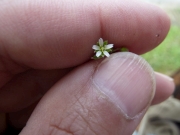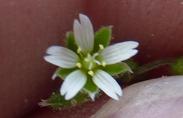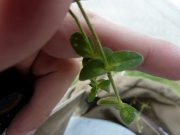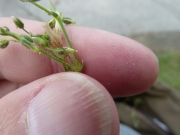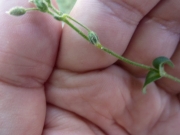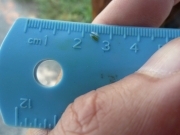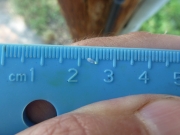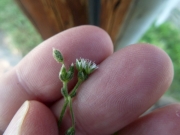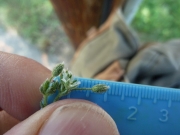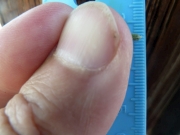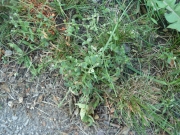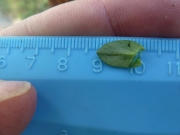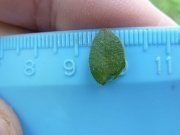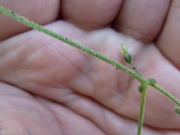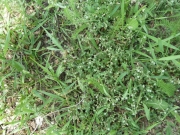Transformational Gardening
May 2012 Foraging Experiences
(Back to:
April 2012 Foraging Experiences)
(Forward to:
June 2012 Foraging Experiences)
May 2, 2012
Coltsfoot (Tussilago farfara)
I rolled dried and crushed Coltsfoot leaves in a organic hemp rolling paper.
As you can see, I have absolutely no skill in rolling cigarettes. But I was
excited that this was my first herbal cigarette! Coltsfoot is very healthy
for the lung when taken in moderation as a tea or by smoking.
I didn't notice much except that smoke usually makes me cough and this did
not make me cough at all.
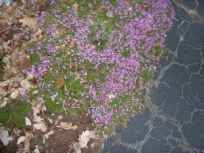
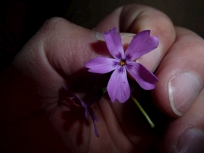
May 3, 2012
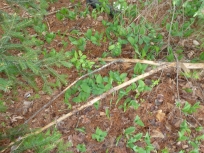
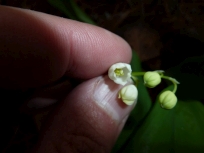 I will take better pictures of this plant in a few weeks and those
pictures will be available on the
European
Lily of the Valley local images web page.
I will take better pictures of this plant in a few weeks and those
pictures will be available on the
European
Lily of the Valley local images web page.
May 5, 2012
I went to a Springtime Foraging for Edible Plants class with
Arthur Haines of the Delta Institute.
The course was on Saturday (10am-4pm) with an extensive plant walk (and harvesting)
Detailed plant identification and use information was presented.
Pictures from the class can be seen on the following web page:
http://www.transformationalgardening.com/forage/spring-foraging-2012-class-a.html
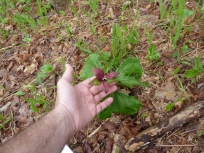
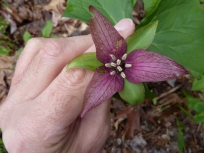 This plant was discussed at the Spring Foraging class today. See above. Normally, I
only consider plants that I find and identify for this web page. Otherwise, I would
not really be learning anything. These pictures of the Red Trillium are from early
this morning, before the foraging class, so I do consider it my find even though it
was discussed later at class.
This plant was discussed at the Spring Foraging class today. See above. Normally, I
only consider plants that I find and identify for this web page. Otherwise, I would
not really be learning anything. These pictures of the Red Trillium are from early
this morning, before the foraging class, so I do consider it my find even though it
was discussed later at class.
It is edible before it flowers in the early Spring (mid- to late-April, perhaps early
May further North). It has a nice cucumber taste which turns more bitter when the plant
flowers. It works well in a salad. The a decoction of the rhizomes (underground stems)
are used medicinally in a poultice for wounds.
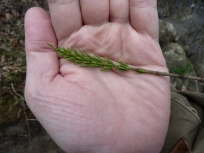
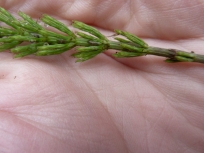 This plant was also identified before the foraging class. I misidentified Marsh Horsetail
last year and removed those pictures. Notice the following features from the pictures
below:
This plant was also identified before the foraging class. I misidentified Marsh Horsetail
last year and removed those pictures. Notice the following features from the pictures
below:
- Length of the first internode of the branch is less than the end of the
subtending stem sheath (to the tip of the stem leaves). See closeup.
- The leaves on the stem have a white margin. See closeup.
- The central cavity is less than 35% of the stem diameter.
May 6, 2012
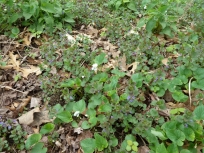
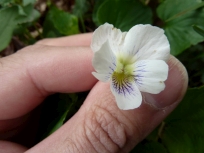 I am about 90% sure that this is Sweet White Violet (Viola blanda), particularly
the palustriformis variation. This variation has lateral (side) flower petals
that are hairy (with rounded tips at the end of the hairs), upper flower petals that
are not strongly reflexed (bent backwards). The leaf blades are rounded or blunt at
the tip and blade is ovate shaped (widest at the top of the leaf).
I am about 90% sure that this is Sweet White Violet (Viola blanda), particularly
the palustriformis variation. This variation has lateral (side) flower petals
that are hairy (with rounded tips at the end of the hairs), upper flower petals that
are not strongly reflexed (bent backwards). The leaf blades are rounded or blunt at
the tip and blade is ovate shaped (widest at the top of the leaf).
The violet that I identified as Smooth White Violet (Viola pallens) on
April 20th may be either a variation of Sweet White Violet (Viola blanda)
or Kidney-Leaved Violet (Viola renifolia).
Using the new botanical guide by Arthur Haines,
Flora
Novae Angliae: A Manual for the Identification of Native and Naturalized
Higher Vascular Plants of New England, you can see the flow of steps used to
identify this species of violet:
- Leaves and flower stems arising from rhizomes (underground stems) or stolons (horizontal
stem creeping along the ground).
- Flower petals mostly purple, violet or white.
- Style (thin tube in the center of flower connecting the ovary) in a scoop-shaped
or conical beak. The ovary is hairless.
- The spur (sticking out of the back of the flower) is 3.2mm long or less and less
than 2 times long as it is wide.
- Flowers relatively smaller with white petals.
- Leaf blades 1.5 times as long (or less) as wide.
- Inner petals of the flower (Corolla) colored white.
- Leaf blades low-serrate.
- Leaf blades broad cordate (heart-shaped) and ovate (wider towards the top).
Midrib 75-90% of total blade width.
- Upper flower petals not strongly reflexed (not strongly bent backwards).
Lateral flower petals commonly hairy. Leaf blades broad to rounded at the tip.
Leaf blade has a wide basal sinus. This indicates that the plant is:
Viola blanda var. palustriformis.
May 9, 2012
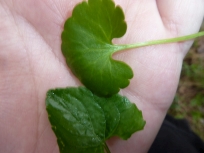
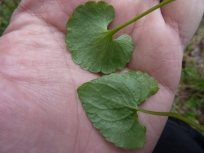 I wanted to show the difference between violet leaves (such as Common Blue Violet,
Viola sororia) and Crowfoot leaves (such as Allegheny Crowfoot,
Ranunculus allegheniensis). The Crowfoot leaves are slightly poisonous.
Notice how the teeth on the crowfoot leaves are blocky and often wider than tall.
I wanted to show the difference between violet leaves (such as Common Blue Violet,
Viola sororia) and Crowfoot leaves (such as Allegheny Crowfoot,
Ranunculus allegheniensis). The Crowfoot leaves are slightly poisonous.
Notice how the teeth on the crowfoot leaves are blocky and often wider than tall.
 Blue Herron (zoom lens).
Blue Herron (zoom lens).
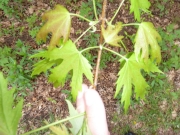
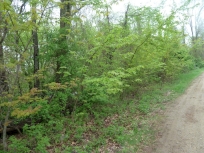 There are only 13 maple tree species in New England. It would be useful to know
them by the leaf shape. Silver Maple has deeply cut lobes and the middle lobe is
narrowed at the base (of the lobe) and its length is greater than 50% of the
length of the leaf blade. The Winter buds are red.
There are only 13 maple tree species in New England. It would be useful to know
them by the leaf shape. Silver Maple has deeply cut lobes and the middle lobe is
narrowed at the base (of the lobe) and its length is greater than 50% of the
length of the leaf blade. The Winter buds are red.
May 10, 2012
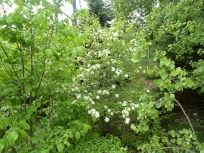
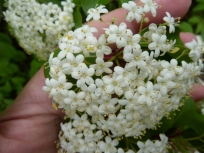 The 5-lobed white flowers formed into flat-topped infloresences and
opposite leaves were a couple keys to see that this is a Viburnum. Two of
the keys to determine what type of Viburnum is whether the leaves are
lobed and whether there are prominent leaf veins that may branch,
but run all of the way to the teeth. In this case the answer to both
questions is, “No.”
The 5-lobed white flowers formed into flat-topped infloresences and
opposite leaves were a couple keys to see that this is a Viburnum. Two of
the keys to determine what type of Viburnum is whether the leaves are
lobed and whether there are prominent leaf veins that may branch,
but run all of the way to the teeth. In this case the answer to both
questions is, “No.”
Using the new botanical guide by Arthur Haines,
Flora
Novae Angliae: A Manual for the Identification of Native and Naturalized
Higher Vascular Plants of New England, you can see the flow of steps used to
identify this species of Viburnum:
- Leaf blades not lobed.
- Winter bud has scales. Only two other Viburnums in New England have unlobed
leaves and no leaf bud scales: Hobblebush (Viburnum lantanoides) has very large
leaves with a large sterile flower surrounded by small fertile flowers. Wayfaring Tree
(Viburnum lantana) has gray stellate (star shaped) hairs on the back of the leaves
and there is a short stalk of the inflorescence (penduncle).
- Leaf blades with many-forked and not prominent pinnate veins that do not extend
to the tip of the teeth. Winter buds with 2 valvate scales.
- Inflorescence (cymes) not elevated on a peduncle.
- Leaf stem (petiole) 10-20 mm long and has a wavy or tiny tooth-like projections.
Some leaf blades have an acuminate tip (gradually tapering to a point with concave
sides along the tip). I could not find many acuminate tips. There were only a few.
But it is not Smooth Blackhaw (Viburnum prunifolium) because those leaf
petioles are only 5-12 mm long.
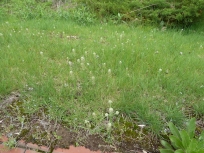
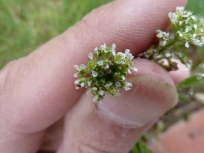 I had thought that there were only a few of these types of plants with little seed pods
growing in a whorl around the stem. Shepherd’s Purse
(Capsella bursa-pastoris), Virginia Pepperweed (Lepidium virginicum),
and Field Pennycress (Thlaspi arvense)
are the ones I knew about. But apparently, there are many others. In order to
differentiate this plant from other in the Lepidium genus:
I had thought that there were only a few of these types of plants with little seed pods
growing in a whorl around the stem. Shepherd’s Purse
(Capsella bursa-pastoris), Virginia Pepperweed (Lepidium virginicum),
and Field Pennycress (Thlaspi arvense)
are the ones I knew about. But apparently, there are many others. In order to
differentiate this plant from other in the Lepidium genus:

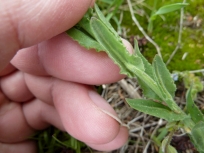
- Seed pod cover is smooth.
- Seed pod cover has a notch at the top.
- Leaves clasp the stem and sometimes the lower leaf blades are
pinnately compound.
- Style barely extended beyond the seed pod notch (if at all).
May 11, 2012
Red Baneberry (Poisonous) ☠
(Actaea rubra)
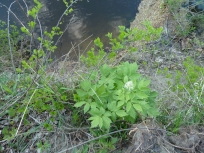
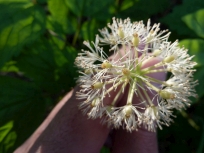 There are not many plants in New England with a ball of flowers, so it makes it
easy to remember. White Baneberry (Actaea pachypoda) looks similar to
Red Baneberry (this plant), but with the following differences:
There are not many plants in New England with a ball of flowers, so it makes it
easy to remember. White Baneberry (Actaea pachypoda) looks similar to
Red Baneberry (this plant), but with the following differences:
- For Red Baneberry, the hood/cap (stigma) sitting on top of the ovary
(inside the flower cluster) is less wide than the ovary. See the
picture of the copper-colored stigma on the pale-yellow ovary (first picture
in the table below). White Baneberry has a stigma that is wider than the ovary.
- Red Baneberry often has some hairs on the back side of the leaflets. See
closeup image below. White Baneberry leaves are hairless or nearly so on the
back side.
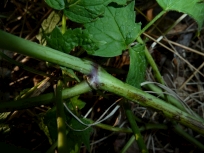
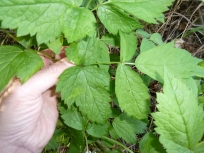
- Red Baneberry flower ball tends to be as wide as it is tall. White Baneberry
tends to have a taller flower cluster than it is wide.
- Most pictures I have seen shows White Baneberry leaflets somewhat smaller and
thinner than Red Baneberry leaflets.
- Red Baneberry pedicel width is 0.3-0.7 mm. White Baneberry pedicel width is
1.0-2.5 mm.
On rare ocassions, Red Baneberry can have white berries and White Baneberry can
have red berries.
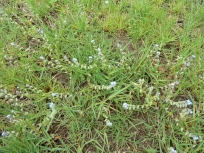
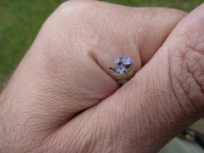 This Forget-Me-Not is differentiated from other Forget-Me-Nots by stems branching
from the base of the plant, hairy thoughout and lower flowers scattered amongst
the leaves. A formal identification looks at:
This Forget-Me-Not is differentiated from other Forget-Me-Nots by stems branching
from the base of the plant, hairy thoughout and lower flowers scattered amongst
the leaves. A formal identification looks at:
- Tips of the hairs on the calyx (out part of flower structure) are hooked.
- Flower petal is 1-2 mm wide.
- Calyx 3-5 mm long and petals blue (or yellow changing to blue)
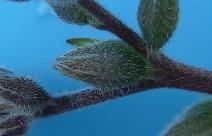
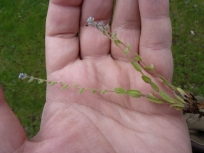
- Flowers scattered amongst the leaves. Flower blue. Hooked hairs along midvein
of underside of leaf.
May 14, 2012
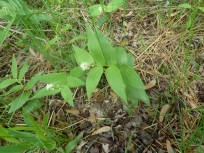
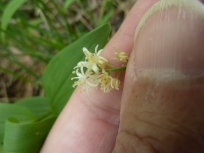 For the last couple of years I was looking for a star-shaped version of False Solomon’s
Seal in hopes of finding Starry False Solomon’s Seal. But there are easier ways
to diferentiate Starry False Solomon’s Seal from Feathery False Solomon’s Seal
(Maianthemum racemosum).
For the last couple of years I was looking for a star-shaped version of False Solomon’s
Seal in hopes of finding Starry False Solomon’s Seal. But there are easier ways
to diferentiate Starry False Solomon’s Seal from Feathery False Solomon’s Seal
(Maianthemum racemosum).
- The flowers of Starry False Solomon’s Seal are arranged in a raceme at
the end of the stem. Notice how each individual flower stalk comes directly off the main
stem of the plant and forms a flower. (Click on first picture to the right.) Now, look
at this
picture of Feathery False Solomon’s Seal and notice how the individual flowers
do not come directly off the main stem, but smaller stems branch off the main stem and
then the flowers grow out of these smaller stems. This is a panicle.
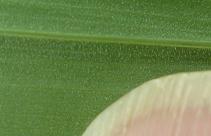
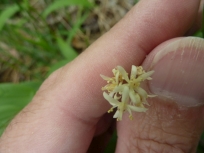
- Feathery False Solomon’s Seal has a redish-brown spot where the leaves connect
to the stem. See the following
image.
This can be seen even on the backside of the leaves before they have fully
opened. Starry False Solomon’s Seal does not have a redish-brown spot.
- The backside of the leaves of Starry False Solomon’s seal have minute hairs.
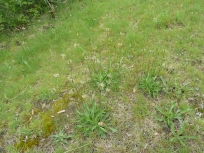
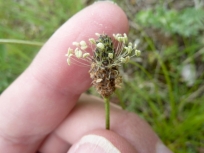 I had given up ever finding Narrowleaf Plantain. Fortunately, the enormously tall
flower stems were up and some of them in flower to make identification a little
more certain. I was thrown off in identification by a couple of the misshapen
flower spikes as seen in some of the pictures below (where it looks like three
flower spikes are fused together).
I had given up ever finding Narrowleaf Plantain. Fortunately, the enormously tall
flower stems were up and some of them in flower to make identification a little
more certain. I was thrown off in identification by a couple of the misshapen
flower spikes as seen in some of the pictures below (where it looks like three
flower spikes are fused together).
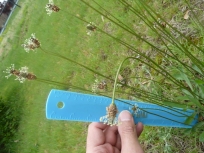
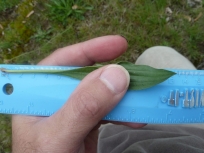 There are more Plantago species in New England than I was aware of (12!).
In addition to the distinctive basal lanceolate to narrowly-elliptical leaves and
the very tall flower stem, one picture flower shows the flower corolla being between
1.5 - 2.5 mm long and a close image shows the sepals being cililate at the tip.
There are more Plantago species in New England than I was aware of (12!).
In addition to the distinctive basal lanceolate to narrowly-elliptical leaves and
the very tall flower stem, one picture flower shows the flower corolla being between
1.5 - 2.5 mm long and a close image shows the sepals being cililate at the tip.
May 15, 2012
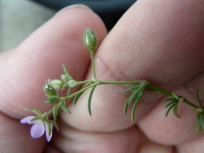
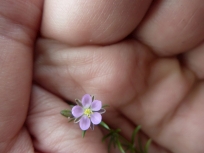 This quick identification owes much thanks to the
XID Services Expert Identification Software.
When I have no idea what genus the plant is in, I often use this software to help
quickly identify the genus and sometimes species rather than flipping through pictures
in field guides and online references. I may be successful with this software in only
20-30% of the plants I look up (since the software only contains 1,000 broadleaf weeds),
but in those cases, it saves me hours. In this case, I marked the following attributes
in the software and three possibilities where returned:
This quick identification owes much thanks to the
XID Services Expert Identification Software.
When I have no idea what genus the plant is in, I often use this software to help
quickly identify the genus and sometimes species rather than flipping through pictures
in field guides and online references. I may be successful with this software in only
20-30% of the plants I look up (since the software only contains 1,000 broadleaf weeds),
but in those cases, it saves me hours. In this case, I marked the following attributes
in the software and three possibilities where returned:
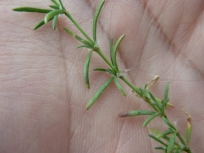
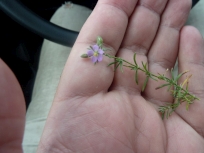
- Flower purple or pink
- Leaf length 5 - 20 mm
- Leaf width < 1 mm
- Location: New Hampshire
Once the three possibilities were returned, I looked at the pictures and determined
that it was either Spergularia rubra or a similar species. I then went to
the botanical guide by Arthur Haines,
Flora
Novae Angliae: A Manual for the Identification of Native and Naturalized
Higher Vascular Plants of New England, to confirm the species.
Spergularia rubra is differentiated from other Spergularia species in
New England by:
- 6-10 stamen per flower
- Evident fascicle of leaves in each axil.
- Seeds 0.4 to 0.6 mm long
- Found in fields, roadsides, lawns (and not coastal beaches and marshes)
May 16, 2012
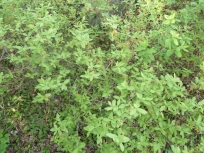
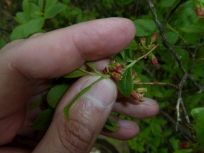 I walked by these plants probably more than 100 times over the last few years and I
never noticed anything. But I’ll be looking for Huckleberries some time this
Summer! Only three Huckleberry plants grow in New England:
I walked by these plants probably more than 100 times over the last few years and I
never noticed anything. But I’ll be looking for Huckleberries some time this
Summer! Only three Huckleberry plants grow in New England:
- Dwarf Huckleberry (Gaylussacia bigeloviana) grows to a height of
only 8 inches to 24 inches (20 - 50 cm).
- Blue Huckleberry (Gaylussacia frondosa) has flower stems that are 10-25 mm
long, blue berries and resin dots on only the back side of the leaves.
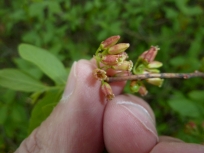
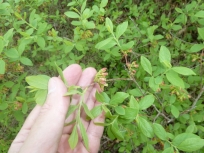
- Black Huckleberry (Gaylussacia baccata) has flower stems that are 7 mm or
less long, flower racemes that do not commonly exceed the leaves, black berries and
resin dots on both sides of the leaves.
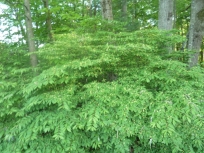
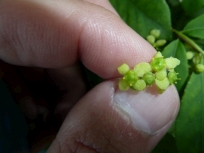 This “burning bush”s is supposed to have bright red leaves in the Fall.
It is distinguished from other Euonymus species by the leaf petioles being
shorter than 5 mm (usually 1-3 mm) and the corky wings on the branchlets. (See last
image below.)
This “burning bush”s is supposed to have bright red leaves in the Fall.
It is distinguished from other Euonymus species by the leaf petioles being
shorter than 5 mm (usually 1-3 mm) and the corky wings on the branchlets. (See last
image below.)
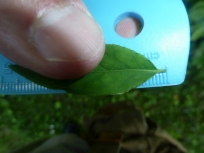
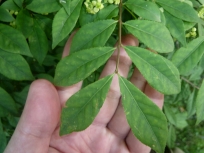
May 17, 2012
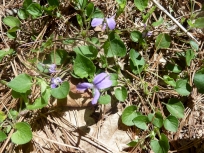
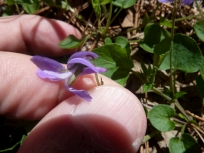 One of the few purple violet species where the leaves and flower stalks grow
out of a stem (rather than out of the ground). Notice that this plant and its
leaves are very small compared to Viola sororia (for example).
One of the few purple violet species where the leaves and flower stalks grow
out of a stem (rather than out of the ground). Notice that this plant and its
leaves are very small compared to Viola sororia (for example).
- Leafy aerial stems with flower stalk arising from leaf axil.
- Plant perennial from rhizomes.
- Petals violet, sepals not ciliate -- not hairy on the sepal margin.
- Spur 2.8 - 7 mm long.
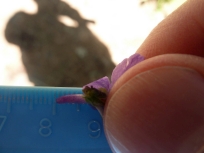
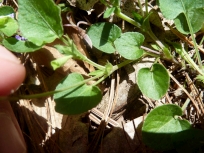
- Leaf petioles distinctly winged. Leaf blades ovate to triangular in shape.
Back of leaf blades has some hairs. Style has a bent tip that is as long as the
diameter of the style.
May 18, 2012
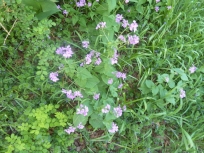
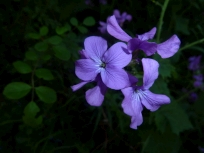 The easiest way to identify a plant near someone's house is for the homeowner to come
out and tell you what was planted! There are a couple of interesting things about this
plant:
The easiest way to identify a plant near someone's house is for the homeowner to come
out and tell you what was planted! There are a couple of interesting things about this
plant:
- This plant looks very similar to the edible plant, Dame’s Rocket
(Hesperis matronalis). Dame’s Rocket flowers are flatter (the petals
are much less curved down) and there is much more separation between the flower
petals. Dame’s Rocket leaves are
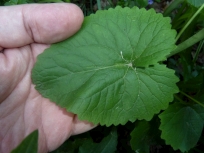
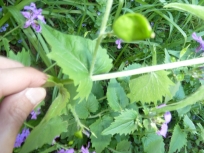 longer and lanceolate (especially the lower leaves)
to narrowly-oval while Annual Honesty leaves tend to be more triangular or heart-shaped.
For comparison, see the following page for
local
pictures of Dame’s Rocket.
longer and lanceolate (especially the lower leaves)
to narrowly-oval while Annual Honesty leaves tend to be more triangular or heart-shaped.
For comparison, see the following page for
local
pictures of Dame’s Rocket.
- The seed pods have the appearance of large, translucent silver coins.
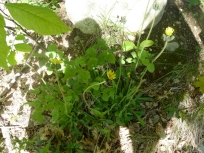
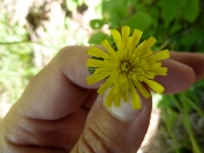 There are only four yellow flower hawkweeds that are tall and have few to no stem leaves.
But it is still difficult to tell the difference between them.
There are only four yellow flower hawkweeds that are tall and have few to no stem leaves.
But it is still difficult to tell the difference between them.
- Meadow (Yellow) Hawkweed (Hieracium caespitosum): The involucre (bracts below
the flower) is 7.5 - 9 mm long. As can be seen from the pictures, the involucre of this
plant is less than 6 mm. Also, Meadow Hawkweed has abudant short bristles on the front of
the leaves and short prostrate stolon (horizontal, creeping stem).
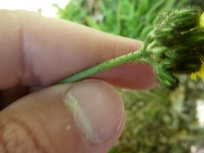
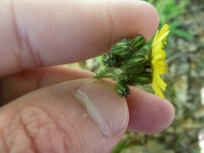
- King Devil Hawkweed (Hieracium xfloribundum): A hybrid of Hieracium
caespitosum and Hieracium lactucella. Early production of prostrate stolons.
The leave blades are glaucous (covered with whitish or bluish waxy coating) and nearly
hairless on the front. Has 3-30 flowers in a tight cluster on short pedicels.
- Glaucous Hawkweed (Hieracium piloselloides): Flower stalk has few or no
stellate hairs. Stellate hairs are star-shaped hairs with several to many branches
radiating from the base. The backs of the basal leaves are hairless or with simple
non-glandular hairs.
- Tall Hawkweed (Hieracium praealtum): Flower stem has moderate to very dense
stellate hairs (see closeup pictures below). Minute stellate hairs are usually found
on the back of the basal leaves, but I did not see many of those hairs (unless I did
not have great enough magnification).
May 19, 2012
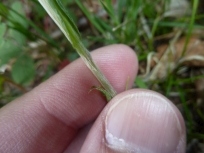
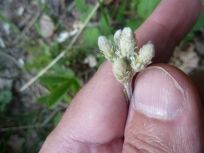 The day before a plant identification class, I found this pussytoes plant a little ways
up a trail in the White Mountains in New Hampshire. There are only five species of
pussytoes in New England. Three of those have basal leaves that are less than
15 mm wide. Out of those three, only two have a “flag” (papery appendage)
at the tip of the stem leaves. Out of those two only Field Pussytoes has a matting of
wooly hairs on the back of the basal leaves.
The day before a plant identification class, I found this pussytoes plant a little ways
up a trail in the White Mountains in New Hampshire. There are only five species of
pussytoes in New England. Three of those have basal leaves that are less than
15 mm wide. Out of those three, only two have a “flag” (papery appendage)
at the tip of the stem leaves. Out of those two only Field Pussytoes has a matting of
wooly hairs on the back of the basal leaves.
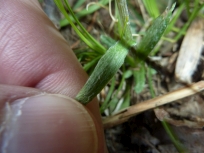
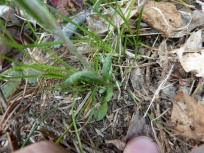
May 21, 2012
Tower Mustard (Turritis glabra) (Previously: Arabis glabra)
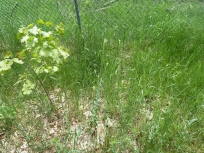
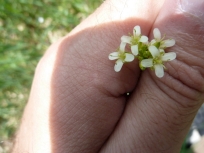 I’ve been munching on the tops of these plants for weeks. The tops
(flowers and buds) of the plant can add some flavor to a salad or are a
good trail nibble. I do not remember seeing the plant last year, but there
are hundreds of them all over the place this year. They plants love to grow
next to foot paths and roads in the full sunlight.
I’ve been munching on the tops of these plants for weeks. The tops
(flowers and buds) of the plant can add some flavor to a salad or are a
good trail nibble. I do not remember seeing the plant last year, but there
are hundreds of them all over the place this year. They plants love to grow
next to foot paths and roads in the full sunlight.
I wanted to be certain that this was Tower Mustard, so I first was able to
identify it as a mustard -- flowers with four petals and six stamen (four long
and two short). Click on the closeup image of the flower below to see
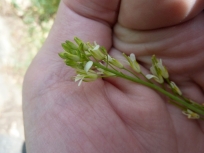
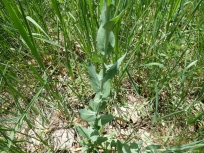 the six stamen
with curled green tops. Then, using the botanical guide by Arthur Haines,
Flora
Novae Angliae: A Manual for the Identification of Native and Naturalized
Higher Vascular Plants of New England, I was able to divine which of the
42 mustard genuses (in New England) that this plant belongs to:
the six stamen
with curled green tops. Then, using the botanical guide by Arthur Haines,
Flora
Novae Angliae: A Manual for the Identification of Native and Naturalized
Higher Vascular Plants of New England, I was able to divine which of the
42 mustard genuses (in New England) that this plant belongs to:
- Fruit/Seed Pod is a silique (more than 3 times as long as wide).
- Seed pods lacking cross-septa (partitions between the seeds). Inside
the pod is not corky or spongy. See closeup image of open seed pod below.
- All leave blades simple, untooth and lacking pronounced lobes.
- Plant partly or entirely with branched hairs. See closeup image of the
top of a leaf blade showing tiny, branched hairs.
- Middle stem leaves are clasping the stem.
- Seed pods 0.8 - 1.3 mm wide.
- Seed pods circular in cross-section (not flattened). See closeup of seed pod below.
Middle and upper stem leaves glaucous (covered with a whitish or bluish waxy coating).
Sepal base without a pouch. Flower petals are supposed to be pale yellow,
but most of them look very white.
Fortunately, once I narrowed it down to the Turritis genus,
there was only one species of that genus in New England, Turritis glabra.
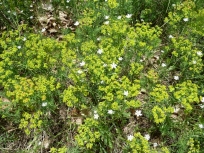
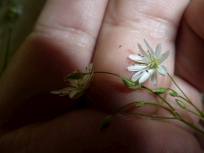 I am still hoping to find a chickweed (Cerastium) one day. Both chickweed and
stitchworts are members of the Pink (Carnation) Family (Caryophyllaceae).
Plants in that family commonly have opposite leaves, nodes just below the leaves
are swollen, flowers with five petals and five sepals. Stitchworts and chickweeds have
five flower petals that are split, making it look like there are 10 petals. Stitchwort
flowers have only three styles while chickweed flowers have five (rarely four) styles.
Click on the closeup picture of the flower below and notice how the three, white, bent
pipe-cleaner-like things in the very center of the flower are the styles.
I am still hoping to find a chickweed (Cerastium) one day. Both chickweed and
stitchworts are members of the Pink (Carnation) Family (Caryophyllaceae).
Plants in that family commonly have opposite leaves, nodes just below the leaves
are swollen, flowers with five petals and five sepals. Stitchworts and chickweeds have
five flower petals that are split, making it look like there are 10 petals. Stitchwort
flowers have only three styles while chickweed flowers have five (rarely four) styles.
Click on the closeup picture of the flower below and notice how the three, white, bent
pipe-cleaner-like things in the very center of the flower are the styles.
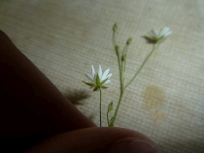
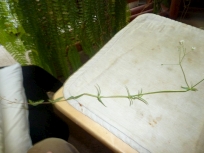 To see what type of stitchwort this is, I had to go through the key in the
botanical guide by Arthur Haines,
Flora
Novae Angliae: A Manual for the Identification of Native and Naturalized
Higher Vascular Plants of New England:
To see what type of stitchwort this is, I had to go through the key in the
botanical guide by Arthur Haines,
Flora
Novae Angliae: A Manual for the Identification of Native and Naturalized
Higher Vascular Plants of New England:
- All leaves are sessile (no leave stems) and plant stems are hairless.
- Leafy bracts below the flowers are scarious (thin, dry and often paper-like
and translucent) and with a green stripe down the center. See the closeup of the
translucent, green-striped leafy bract below.
- Flowers are produced at the top of the stem. Sepals 2-7 mm long (in this case
4 mm long).
- Sepals are conspicuously 3-veined. See closeup image of 3-veined sepals below.
Stems smooth. Leaf blades widest below the middle.
May 22, 2012
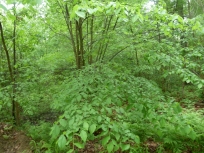
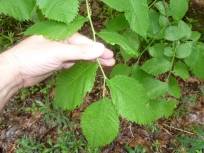 I am still fairly weak in my knowledge of trees and find it challenging to
identify trees that seem easy for others to learn. This one appears to be
American Elm. Elm tree leaves have double-serrated teeth, meaning that
the teeth have smaller teeth on them. The main teeth on these leaves are
so large that you have to look closely to see the smaller teeth within
the bigger teeth. Leaves are alternate and have uneven bases.
I am still fairly weak in my knowledge of trees and find it challenging to
identify trees that seem easy for others to learn. This one appears to be
American Elm. Elm tree leaves have double-serrated teeth, meaning that
the teeth have smaller teeth on them. The main teeth on these leaves are
so large that you have to look closely to see the smaller teeth within
the bigger teeth. Leaves are alternate and have uneven bases.
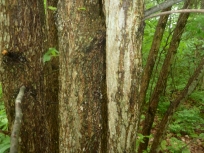
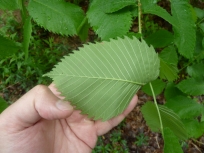 One of the most certain ways to tell the difference between American Elm and
Slipper Elm (Ulmus rubra) is the lateral veins on the American Elm leaf
blade do not fork (branch) until near the edge (margin) of the leaf. (In rare
cases, one lateral vein may have a fork well before the edge on an American Elm
leaf.) On a Slipper Elm leaf, the there will be at least two and sometimes many forks
well before the edge of the leaf. In addition, Slipper Elm leaves tend to be rough
on the top of the leaf and much more densely hairy on the back of the leaf. Buds
and twigs on the American Elm tend to be brownish while twigs on the Slippery Elm
are grayish and the buds are rusty brown to black. Finally, cutting a cross section
of bark from American Elm will show an alternating pale and dark bands which are not
seen in Slippery Elm bark.
One of the most certain ways to tell the difference between American Elm and
Slipper Elm (Ulmus rubra) is the lateral veins on the American Elm leaf
blade do not fork (branch) until near the edge (margin) of the leaf. (In rare
cases, one lateral vein may have a fork well before the edge on an American Elm
leaf.) On a Slipper Elm leaf, the there will be at least two and sometimes many forks
well before the edge of the leaf. In addition, Slipper Elm leaves tend to be rough
on the top of the leaf and much more densely hairy on the back of the leaf. Buds
and twigs on the American Elm tend to be brownish while twigs on the Slippery Elm
are grayish and the buds are rusty brown to black. Finally, cutting a cross section
of bark from American Elm will show an alternating pale and dark bands which are not
seen in Slippery Elm bark.
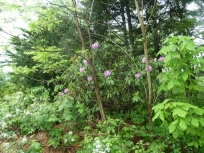
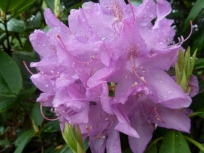 Supposedly, the only New England state that this plant grows in is Massachusetts. But
Rhododendrons can be planted anywhere. This was found in a clump of bushes, very close
to a business. Pink flowers, no scales on the leaves (see closeup image) and large
leaves (10-20 cm long) led me to two possible Rhododendron choices. Short sepals
(0.5 - 1.7 mm long) and wider leaves (1.5 - 2.5 times as long as wide) helped me
decide that this was Catawba Rosebay.
Supposedly, the only New England state that this plant grows in is Massachusetts. But
Rhododendrons can be planted anywhere. This was found in a clump of bushes, very close
to a business. Pink flowers, no scales on the leaves (see closeup image) and large
leaves (10-20 cm long) led me to two possible Rhododendron choices. Short sepals
(0.5 - 1.7 mm long) and wider leaves (1.5 - 2.5 times as long as wide) helped me
decide that this was Catawba Rosebay.
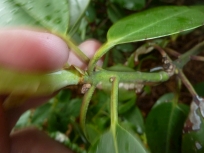
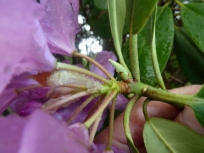
May 23, 2012
Mouse-Ear Chickweed (Cerastium fontanum) (Previously: Cerastium vulgatum)
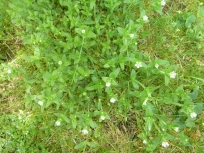
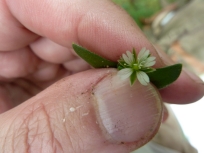 My first time locating a chickweed! A nice-sized patch of it was no more than
50 yards from my front door!
My first time locating a chickweed! A nice-sized patch of it was no more than
50 yards from my front door!
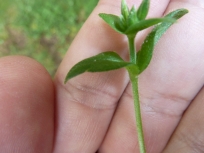
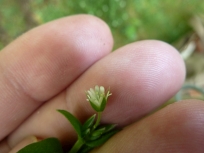
May 24, 2012
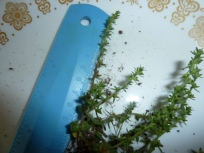
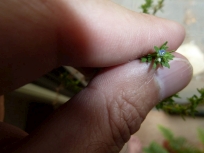 This flower is so tiny that it’s hard to see unless your face is on top
of the plant. Like the Thyme-Leaved Speedwell (Veronica serpyllifolia),
the flowers fall off with the slightest shaking of the plant. Because I dug up
a plant, it was very easy to follow the key to the proper identification:
This flower is so tiny that it’s hard to see unless your face is on top
of the plant. Like the Thyme-Leaved Speedwell (Veronica serpyllifolia),
the flowers fall off with the slightest shaking of the plant. Because I dug up
a plant, it was very easy to follow the key to the proper identification:
- Flower racemes terminating the main stem (as opposed to in the leaf axils).
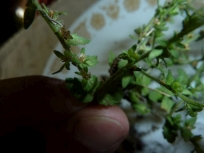
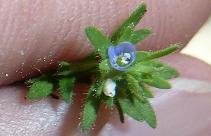
- Plant annual, from fibrous roots.
- Pedicels (flower stem) very short, up to 2 mm long.
- Flower corolla blue.
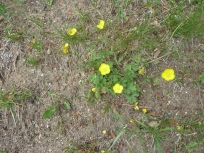
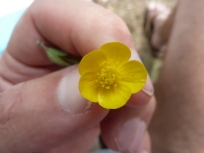 There were a number of things that made this a very difficult identification and
I’m not 100% sure it is accurate. I was taking pictures right outside of
someone’s apartment and I think that were wondering what the *!*$(@ I was
doing! Also, the key led me to information on flower parts and I can’t pick
out flower parts very well. Fortunately, it had the obvious look of a buttercup:
There were a number of things that made this a very difficult identification and
I’m not 100% sure it is accurate. I was taking pictures right outside of
someone’s apartment and I think that were wondering what the *!*$(@ I was
doing! Also, the key led me to information on flower parts and I can’t pick
out flower parts very well. Fortunately, it had the obvious look of a buttercup:
- Petals inserted below the ovary.
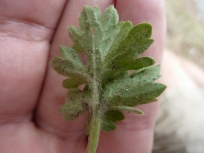
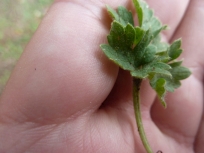
- No stipules.
- Flower has multiple distinct and dissimilar parts.
The key was followed in this way:
- Plants terrestial (not aquatic).
- Some of the leaf blades are lobed or compound.
- Leaves +- monomorphic (relatively similar) and basal leaves are not simple, but are
compound.
- Larger leaves are compound (have unwinged petiolules).
- Petals 6 - 15 mm long.
- Sepals reflexed (bent backwards), not spreading. Every flower had its sepals
reflexed. According to the text, it is supposed to be reflexed 2-3 mm above the base
of the sepal, but I do not see that in this plant or any pictures I can find. But
it is not Creeping Buttercup (Ranunculus repens) because the sepals are not
spreading.
- Stems thickened into a bulb at the base. See the last two pictures in the table
below. The flower petals are supposed to be 9-13 mm long. The one I measured was
8-1/2 mm long ... close enough.
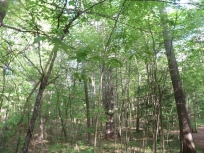
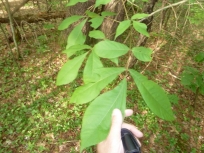 Fortunately, there are not many trees that have pinnately-compound leaves. In this case,
every leaf had very large, toothed leaflets. The only trees that are pinnately-compound
and with leaflets this big are the hickory (Carya) species. Since there are only five
species of hickory in New England, I thought it would be easy. I narrowed it down to
Shagbark Hickory (Carya ovata) and Pignut Hickory (Carya glabra).
Fortunately, there are not many trees that have pinnately-compound leaves. In this case,
every leaf had very large, toothed leaflets. The only trees that are pinnately-compound
and with leaflets this big are the hickory (Carya) species. Since there are only five
species of hickory in New England, I thought it would be easy. I narrowed it down to
Shagbark Hickory (Carya ovata) and Pignut Hickory (Carya glabra).
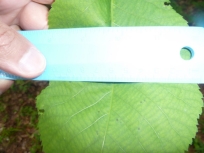
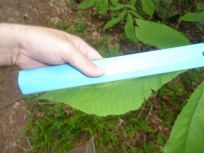 Click on
the two closeup pictures of the leaf teeth below (and then click one more time to expand
again) to see that the leaf margins have clumps of hair near the teeth. This is a sign
that this tree is Shagbark Hickory. The tree is not old enough for the bark to shag into
long plates that are free at the bottom.
Click on
the two closeup pictures of the leaf teeth below (and then click one more time to expand
again) to see that the leaf margins have clumps of hair near the teeth. This is a sign
that this tree is Shagbark Hickory. The tree is not old enough for the bark to shag into
long plates that are free at the bottom.

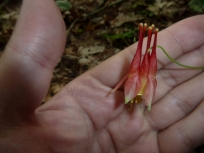 I love the look of this flower! And it was easy to identify! Trifoliate leaves.
It is a member of the Buttercup family.
I love the look of this flower! And it was easy to identify! Trifoliate leaves.
It is a member of the Buttercup family.
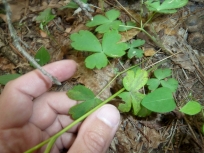
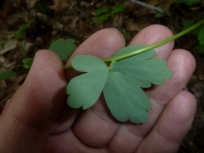
May 25, 2012
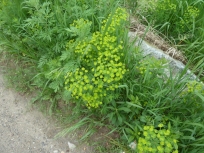
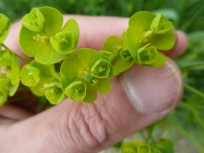 I have been looking for Leafy Spurge ever since I found the similar Cypress Spurge
(Euphorbia cyparissias) a few years ago. Leafy spurge is clearly much bigger
and with much larger leaves. There is a rare hybrid of these two plants known as
Euphorbia x pseudoesula. The leaf blades of the hybrid appear 35 mm long and
3 mm wide and a similar shape as Cypress Spurge leaves (narrow and linear). But the
flowers are found in both a terminal cyme and in the leaf axils similar to Leafy
Spurge.
I have been looking for Leafy Spurge ever since I found the similar Cypress Spurge
(Euphorbia cyparissias) a few years ago. Leafy spurge is clearly much bigger
and with much larger leaves. There is a rare hybrid of these two plants known as
Euphorbia x pseudoesula. The leaf blades of the hybrid appear 35 mm long and
3 mm wide and a similar shape as Cypress Spurge leaves (narrow and linear). But the
flowers are found in both a terminal cyme and in the leaf axils similar to Leafy
Spurge.
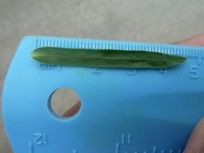
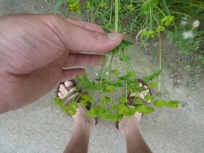 Some might categorize this plant as Russian Leafy Spurge (Slender Leafy Spurge)
(Euphorbia virgata) because stem leaf blades are linear, greater than
six times longer than wide and widest below the middle. However, some authors
categorize Russian Leafy Spurge as a subspecies (Euphorbia esula ssp.
tommasiniana), some categorize it s a variety (Euphorbia esula var.
uralensis or Euphorbia esula var. orientalis) and some consider it a
separate species (Euphorbia virgata). In addition, some authors recognize
a hybrid between Euphorbia esula and Eurphorbia virgata and call
that hybrid Euphorbia x pseudovirgata. Until the confusion is worked out,
I will categorize this plant as Euphorbia esula and leave it to the botanists
to figure it out.
Some might categorize this plant as Russian Leafy Spurge (Slender Leafy Spurge)
(Euphorbia virgata) because stem leaf blades are linear, greater than
six times longer than wide and widest below the middle. However, some authors
categorize Russian Leafy Spurge as a subspecies (Euphorbia esula ssp.
tommasiniana), some categorize it s a variety (Euphorbia esula var.
uralensis or Euphorbia esula var. orientalis) and some consider it a
separate species (Euphorbia virgata). In addition, some authors recognize
a hybrid between Euphorbia esula and Eurphorbia virgata and call
that hybrid Euphorbia x pseudovirgata. Until the confusion is worked out,
I will categorize this plant as Euphorbia esula and leave it to the botanists
to figure it out.
One interesting item I noticed when reading about the different varieties is that
Leafy Spurge had its own newsletter called
Leafy Spurge News.
May 26, 2012
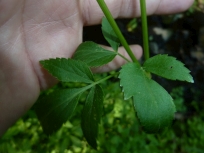
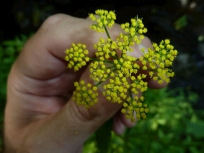 I went to a 3-hour presentation on Edible Forest Gardens. It was inspiring! Then I
want for a walk at a nearby set of trails. This is one of many new and interesting
plants flowering by the stream.
I went to a 3-hour presentation on Edible Forest Gardens. It was inspiring! Then I
want for a walk at a nearby set of trails. This is one of many new and interesting
plants flowering by the stream.
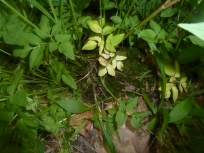

Wild Chives (Allium schoenoprasum)
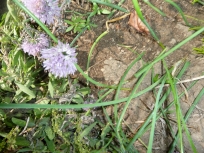
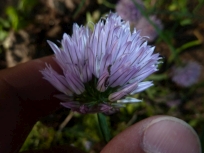 These plants were growing right between at the edge of a parking lot that is
adjacent to a forest walking path. Other plants growing in this weedy area were
species of bedstraw, speedwell, buttercup, periwinkle and wild carrot. When you
do not grow your own vegetables, you have no idea what the flowering plant looks
like.
These plants were growing right between at the edge of a parking lot that is
adjacent to a forest walking path. Other plants growing in this weedy area were
species of bedstraw, speedwell, buttercup, periwinkle and wild carrot. When you
do not grow your own vegetables, you have no idea what the flowering plant looks
like.
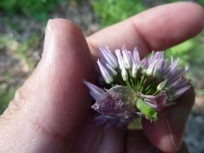
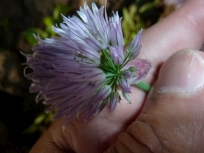
Cinnamon Fern (Osmunda cinnamomea) (Also known as: Osmundastrum
cinnamomeum)
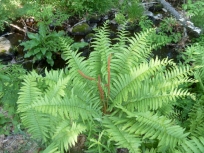
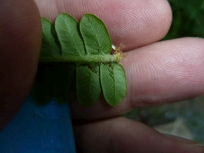 Other than Sensative Fern (Onoclea sensibilis), which is easy to identify, this is my very first
fern identification that I have done on my own! I was not planning on identifying ferns,
but that big cinnamon-colored center part of the fern rosette made identification possible.
Cinnamon Fern has a circular rosette of leaves (called fronds) that are infertile and
then one or more central, cinnamon-colored fertile fronds (that release spores).
Other than Sensative Fern (Onoclea sensibilis), which is easy to identify, this is my very first
fern identification that I have done on my own! I was not planning on identifying ferns,
but that big cinnamon-colored center part of the fern rosette made identification possible.
Cinnamon Fern has a circular rosette of leaves (called fronds) that are infertile and
then one or more central, cinnamon-colored fertile fronds (that release spores).
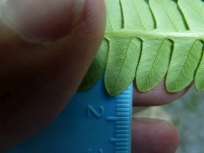
 Each large leaf has many leaflets that get smaller as they approach the tip of the leaf.
In the first top picture (above), to the right, we are looking at the back of part of
one leaflet. There is hairy fuzz where the leaflet connects to the leaf stem. Some
people call this “hairy armpits” and is a significant identifying feature
of Cinnamon Fern. Notice that the leaflets are very deeply cut, almost into leafules
(leaflets of leaflets), but not quite. Identification keys include:
“hairy armpits”; thin, cinnamon-colored fertile frond; and leaflets of
infertile front coming to a point (see last picture below).
Each large leaf has many leaflets that get smaller as they approach the tip of the leaf.
In the first top picture (above), to the right, we are looking at the back of part of
one leaflet. There is hairy fuzz where the leaflet connects to the leaf stem. Some
people call this “hairy armpits” and is a significant identifying feature
of Cinnamon Fern. Notice that the leaflets are very deeply cut, almost into leafules
(leaflets of leaflets), but not quite. Identification keys include:
“hairy armpits”; thin, cinnamon-colored fertile frond; and leaflets of
infertile front coming to a point (see last picture below).
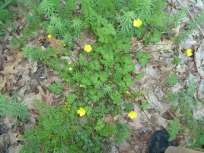
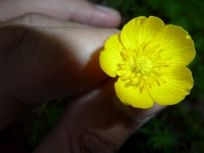 The light-colored splotches (spots) on the tops of the leaves help identify this Buttercup.
Notice in the pictures below that the sepals are spread (not recurved down), the plant
spreads with runners.
The light-colored splotches (spots) on the tops of the leaves help identify this Buttercup.
Notice in the pictures below that the sepals are spread (not recurved down), the plant
spreads with runners.
The key was followed in this way:
- Plants terrestial (not aquatic).
- Some of the leaf blades are lobed or compound.
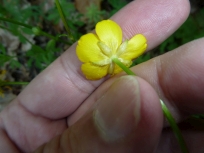
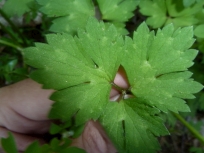
- Leaves +- monomorphic (relatively similar) and basal leaves are not simple, but are
compound.
- Larger leaves are compound (have unwinged petiolules).
- Petals 6 - 15 mm long.
- Sepals spreading.
- Flower petals widest above the midde. Roots slender.
- Style is short and curved.
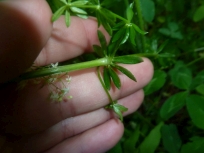
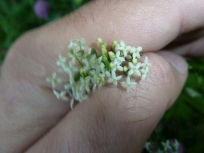 There are 22 Bedstraw (Galium) species in New England. Fortunately, half of
those species have four or fewer leaves at each node. This species was keyed out as
follows:
There are 22 Bedstraw (Galium) species in New England. Fortunately, half of
those species have four or fewer leaves at each node. This species was keyed out as
follows:
- Main branches with 5-12 leaves at each node.
- Leaf blades sharply pointed to cuspidate at the apex.
- Corolla 1-7 mm in diameter.
- Pedicels erect to spreading.
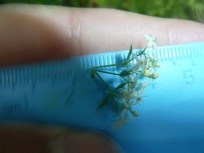
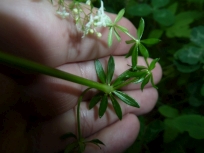
- Stems not rough to touch.
- Corolla not funnelform.
- Leaf blades linear to elliptic, 2-10 mm wide.
- Leaf blades 10-25 mm long.
- Pedicel length usually shorter than diameter of flower. Corolla 3-5 mm in
diameter.
May 27, 2012
Pink Corydalis (Rock Harlequin) (Capnoides sempervirens)
(Also known as: Corydalis sempervirens)
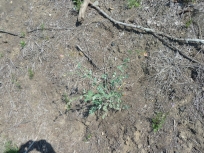
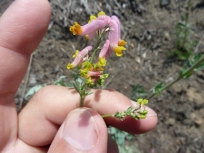 I walked by this area 100 times last year and did not see this plant. But there was
only one of these plants in the dirt about 50 feet from a corn field (probably
genetically manipulated corn). I guess I’m a little miffed at this farm
because they leased some of the land from the city and then cleared the land to plant
corn. By doing so they destroyed a great field with Sowthistle, Lobelia,
Canada Thistle, Red Clover and Hedge False Bindweed. This is my second favorite
flower after Red Columbine.
I walked by this area 100 times last year and did not see this plant. But there was
only one of these plants in the dirt about 50 feet from a corn field (probably
genetically manipulated corn). I guess I’m a little miffed at this farm
because they leased some of the land from the city and then cleared the land to plant
corn. By doing so they destroyed a great field with Sowthistle, Lobelia,
Canada Thistle, Red Clover and Hedge False Bindweed. This is my second favorite
flower after Red Columbine.
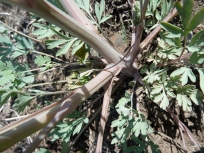
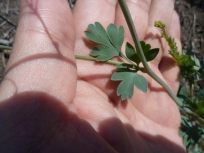
Giant Chickweed (Myosoton aquaticum)
(Also known as: Cerastium aquaticum and Stellaria aquatica)
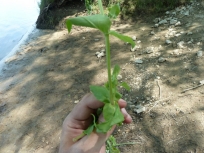
 I found giant chickweed growing next to a corn field. Given the species name,
aquaticum, I would have expected to find it near water. On the other hand,
perhaps it is getting some water for the watering of the corn field. So, I went through
the whole Caryophyllaceae (Pink) family to see if it could be anything else:
I found giant chickweed growing next to a corn field. Given the species name,
aquaticum, I would have expected to find it near water. On the other hand,
perhaps it is getting some water for the watering of the corn field. So, I went through
the whole Caryophyllaceae (Pink) family to see if it could be anything else:
- Sepals distinct or essentially so (not connate at base).
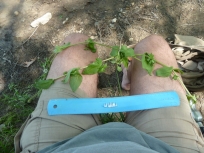
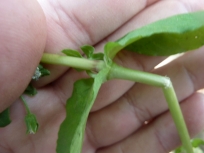
- Leaves without stipules. I was unsure if the pictures showed stipules or
something else growing out of the leaf base, so I followed the key in both
directions. If those were stipules, then the key led me to the Sand Spurry genus
(Spergularia) and I know this is not a Sand Spurry.
- Flower is hypogynus -- superior ovary without a hypanthium (cup-like tissue from
fusion of basal portion of sepals, petals and stamens).
- Both sepals and petals are present.
- Petals are deeply notched.
- 4 or 5 styles.
- Leaf blades 10-40 mm wide.
The simple way to identify it might be that it was 5 deeply-notched white petals
with 5 styles and very big opposite leaves. The plants were growing in the sun, so
I picked one plant to carry to a spot with some shade for better pictures.
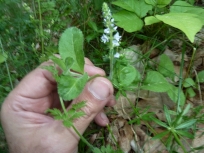
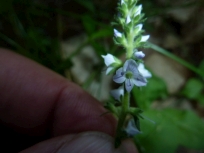 Barely touching this plant will make the flowers fall off, just like Corn Speedwell and
Thyme-Leaved Speedwell. It was dusk and the mosquitoes were swarming and I was lying in
the tick-infested grass and being as still as humanly possible to try and take pictures
without all of the flowers falling off.
Barely touching this plant will make the flowers fall off, just like Corn Speedwell and
Thyme-Leaved Speedwell. It was dusk and the mosquitoes were swarming and I was lying in
the tick-infested grass and being as still as humanly possible to try and take pictures
without all of the flowers falling off.
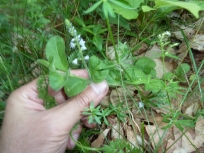
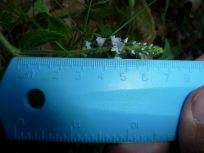 Key:
Key:
- Racemes borne in the leaf axils.
- Stems and leaf blades conspicuously pubescent.
- Corolla 4-8 mm wide. Flowering stems creeping near base with tip ascending.
May 28, 2012
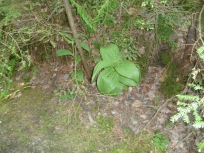
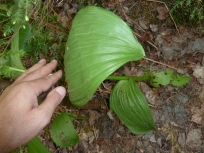 This plant is poisonous, the root being the most poisonous part. However, Native
Americans and herbalists have used minute amounts of the rhizome medicinally, harvested
in the Winter when the poison levels are at their lowest.
This plant is poisonous, the root being the most poisonous part. However, Native
Americans and herbalists have used minute amounts of the rhizome medicinally, harvested
in the Winter when the poison levels are at their lowest.
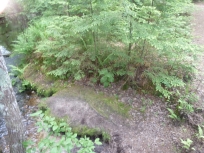
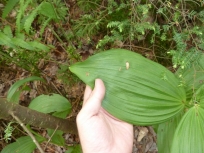
May 29, 2012
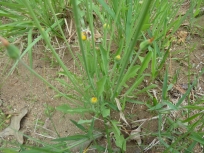
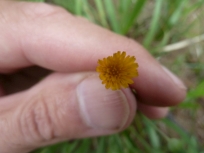 I kept thinking that this might be Red-Seeded Dandelion (Taraxacum laevigatum)
because it looked like a small dandelion. There were hundreds of these plants by a farm
and a few by my home. I went through the entire key for the Aster Family (Asteraceae)
to confirm identification!
I kept thinking that this might be Red-Seeded Dandelion (Taraxacum laevigatum)
because it looked like a small dandelion. There were hundreds of these plants by a farm
and a few by my home. I went through the entire key for the Aster Family (Asteraceae)
to confirm identification!

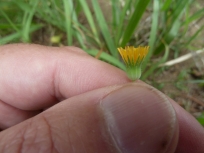 If you look at the pictures below, you can see closeups of the pappus. A pappus is a
modified outer whorl of flowers of the Asteraceae family. It consists of the
achene (seed) with bristles or scales at the top of the achene. This species has five
white scales (that look a bit like flower petals) and five long bristles. A related
species, Two-Flowered Dwarf Dandelion (Krigia biflora) has 10 scales and 20-35
long bristles.
If you look at the pictures below, you can see closeups of the pappus. A pappus is a
modified outer whorl of flowers of the Asteraceae family. It consists of the
achene (seed) with bristles or scales at the top of the achene. This species has five
white scales (that look a bit like flower petals) and five long bristles. A related
species, Two-Flowered Dwarf Dandelion (Krigia biflora) has 10 scales and 20-35
long bristles.
May 30, 2012
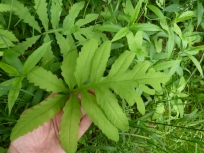
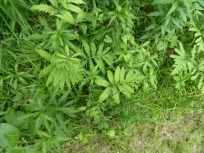 I must have forgotten to post this plant to the web page last year. It is the easiest
ferm to identify because it’s so unique-looking. Only the Netted Chain Fern
(Woodwardia areolata) has any resemblence to Sensitive Fern. There are some
obvious differences:
I must have forgotten to post this plant to the web page last year. It is the easiest
ferm to identify because it’s so unique-looking. Only the Netted Chain Fern
(Woodwardia areolata) has any resemblence to Sensitive Fern. There are some
obvious differences:
- Netted Chain Fern has minutely-toothed leaflets while Sensitive Fern is lobed, but
untoothed (entire).
- The margins of Netted Chain Fern leaflets are wavy.
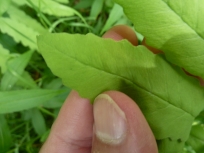
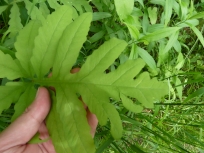
- The leaflets of the Netted Chain Fern are narrower and less lobed.
- The fertile frond of Sensitive Fern is a stalk with a beaded head that is produced
in the mid-Summer and lasts through Winter. The fertile front of Netted Chain Fern is
similar in shape to the infertile frond, but with much narrower leaflets. It also lasts
through the Winter.
May 31, 2012
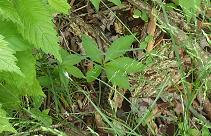
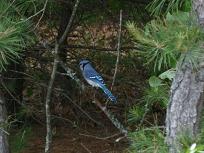 More than plants on the trails!
More than plants on the trails!

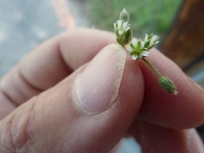 This plant doesn't grow as upright as Mouse-Ear Chickweed (Cerastium fontanum).
But the main differences are that this plant does not have sprawling stems that root
at the nodes and the flower has five stamen.
This plant doesn't grow as upright as Mouse-Ear Chickweed (Cerastium fontanum).
But the main differences are that this plant does not have sprawling stems that root
at the nodes and the flower has five stamen.
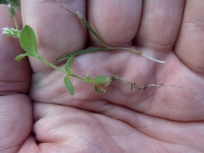
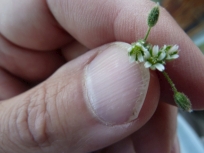
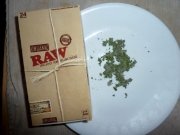

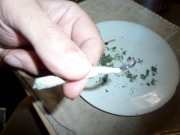





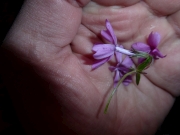
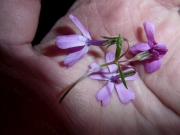
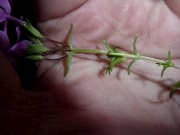
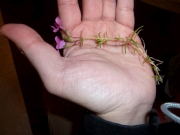

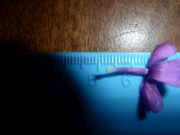
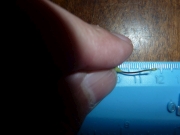
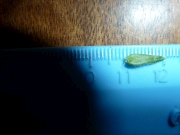
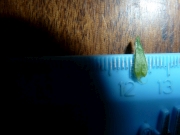

 I will take better pictures of this plant in a few weeks and those
pictures will be available on the
European
Lily of the Valley local images web page.
I will take better pictures of this plant in a few weeks and those
pictures will be available on the
European
Lily of the Valley local images web page.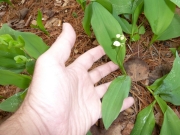
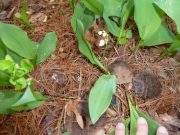
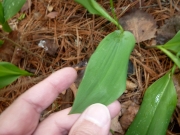
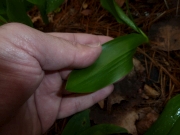
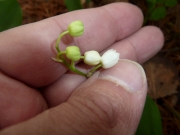


 This plant was discussed at the Spring Foraging class today. See above. Normally, I
only consider plants that I find and identify for this web page. Otherwise, I would
not really be learning anything. These pictures of the Red Trillium are from early
this morning, before the foraging class, so I do consider it my find even though it
was discussed later at class.
This plant was discussed at the Spring Foraging class today. See above. Normally, I
only consider plants that I find and identify for this web page. Otherwise, I would
not really be learning anything. These pictures of the Red Trillium are from early
this morning, before the foraging class, so I do consider it my find even though it
was discussed later at class.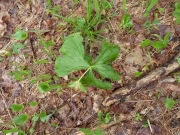
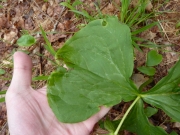
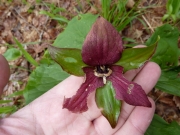
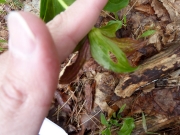
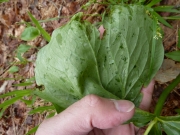
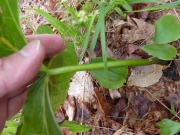
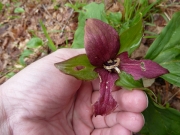
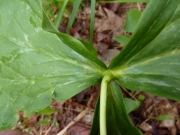
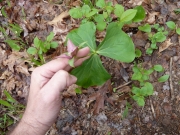

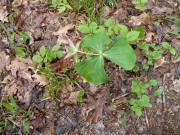

 This plant was also identified before the foraging class. I misidentified Marsh Horsetail
last year and removed those pictures. Notice the following features from the pictures
below:
This plant was also identified before the foraging class. I misidentified Marsh Horsetail
last year and removed those pictures. Notice the following features from the pictures
below: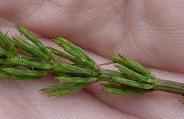
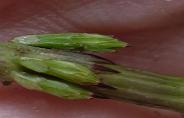
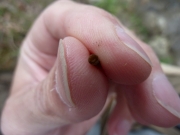
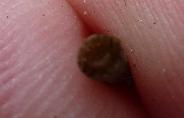
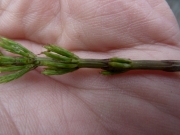

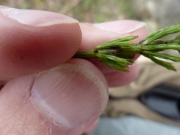

 I am about 90% sure that this is Sweet White Violet (Viola blanda), particularly
the palustriformis variation. This variation has lateral (side) flower petals
that are hairy (with rounded tips at the end of the hairs), upper flower petals that
are not strongly reflexed (bent backwards). The leaf blades are rounded or blunt at
the tip and blade is ovate shaped (widest at the top of the leaf).
I am about 90% sure that this is Sweet White Violet (Viola blanda), particularly
the palustriformis variation. This variation has lateral (side) flower petals
that are hairy (with rounded tips at the end of the hairs), upper flower petals that
are not strongly reflexed (bent backwards). The leaf blades are rounded or blunt at
the tip and blade is ovate shaped (widest at the top of the leaf).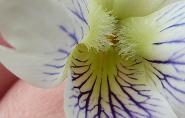
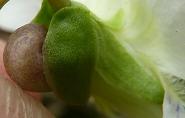
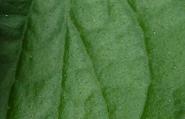
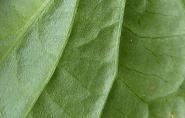
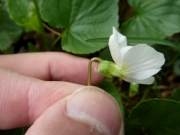
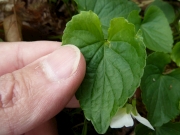
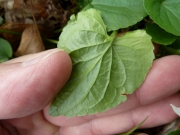

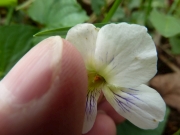
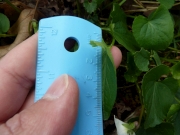
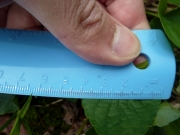

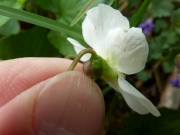
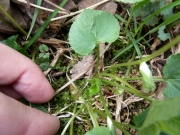

 I wanted to show the difference between violet leaves (such as Common Blue Violet,
Viola sororia) and Crowfoot leaves (such as Allegheny Crowfoot,
Ranunculus allegheniensis). The Crowfoot leaves are slightly poisonous.
Notice how the teeth on the crowfoot leaves are blocky and often wider than tall.
I wanted to show the difference between violet leaves (such as Common Blue Violet,
Viola sororia) and Crowfoot leaves (such as Allegheny Crowfoot,
Ranunculus allegheniensis). The Crowfoot leaves are slightly poisonous.
Notice how the teeth on the crowfoot leaves are blocky and often wider than tall. Blue Herron (zoom lens).
Blue Herron (zoom lens).
 There are only 13 maple tree species in New England. It would be useful to know
them by the leaf shape. Silver Maple has deeply cut lobes and the middle lobe is
narrowed at the base (of the lobe) and its length is greater than 50% of the
length of the leaf blade. The Winter buds are red.
There are only 13 maple tree species in New England. It would be useful to know
them by the leaf shape. Silver Maple has deeply cut lobes and the middle lobe is
narrowed at the base (of the lobe) and its length is greater than 50% of the
length of the leaf blade. The Winter buds are red.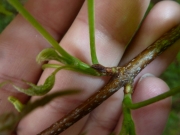
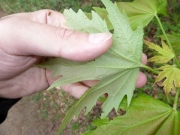
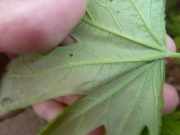
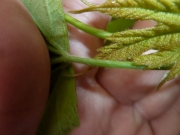
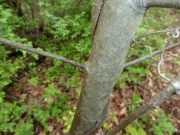
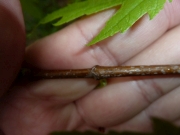
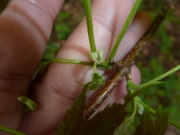
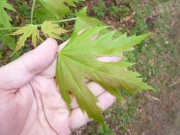
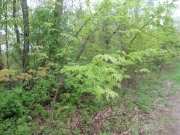

 The 5-lobed white flowers formed into flat-topped infloresences and
opposite leaves were a couple keys to see that this is a Viburnum. Two of
the keys to determine what type of Viburnum is whether the leaves are
lobed and whether there are prominent leaf veins that may branch,
but run all of the way to the teeth. In this case the answer to both
questions is, “No.”
The 5-lobed white flowers formed into flat-topped infloresences and
opposite leaves were a couple keys to see that this is a Viburnum. Two of
the keys to determine what type of Viburnum is whether the leaves are
lobed and whether there are prominent leaf veins that may branch,
but run all of the way to the teeth. In this case the answer to both
questions is, “No.”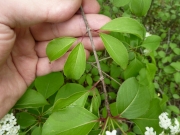
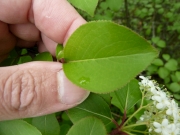
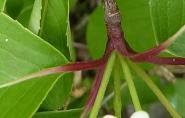
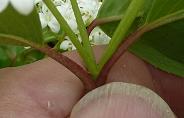
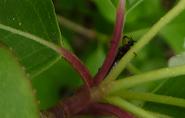

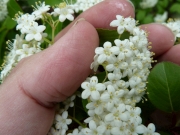
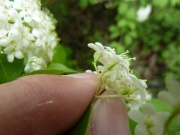
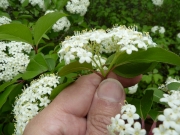
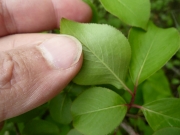
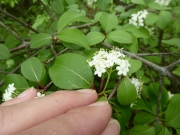
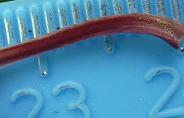
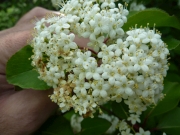
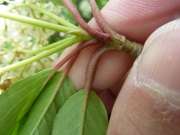
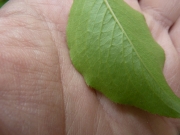
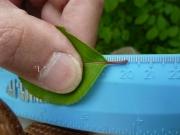
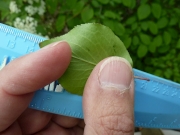
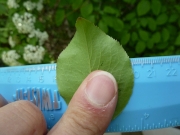
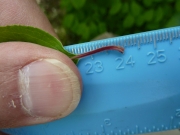
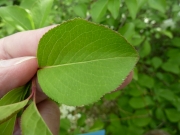
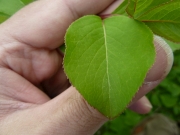
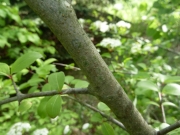
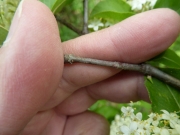
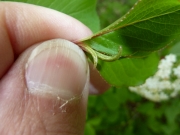
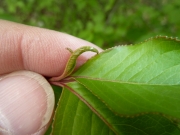
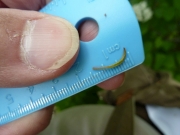

 I had thought that there were only a few of these types of plants with little seed pods
growing in a whorl around the stem. Shepherd’s Purse
(Capsella bursa-pastoris), Virginia Pepperweed (Lepidium virginicum),
and Field Pennycress (Thlaspi arvense)
are the ones I knew about. But apparently, there are many others. In order to
differentiate this plant from other in the Lepidium genus:
I had thought that there were only a few of these types of plants with little seed pods
growing in a whorl around the stem. Shepherd’s Purse
(Capsella bursa-pastoris), Virginia Pepperweed (Lepidium virginicum),
and Field Pennycress (Thlaspi arvense)
are the ones I knew about. But apparently, there are many others. In order to
differentiate this plant from other in the Lepidium genus:


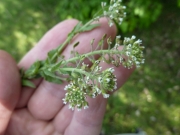
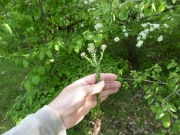
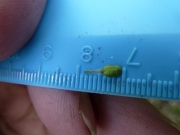
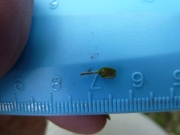
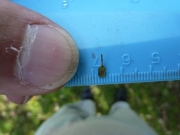
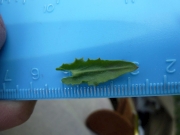
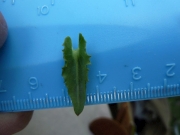
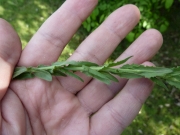
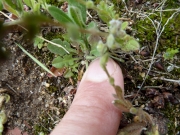
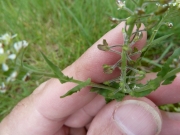
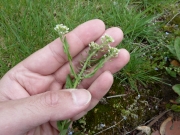
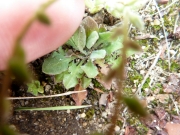
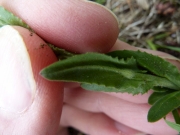
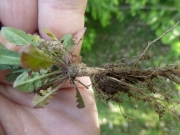
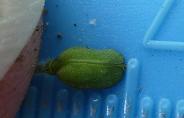
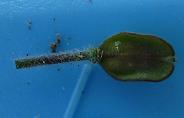

 There are not many plants in New England with a ball of flowers, so it makes it
easy to remember. White Baneberry (Actaea pachypoda) looks similar to
Red Baneberry (this plant), but with the following differences:
There are not many plants in New England with a ball of flowers, so it makes it
easy to remember. White Baneberry (Actaea pachypoda) looks similar to
Red Baneberry (this plant), but with the following differences:

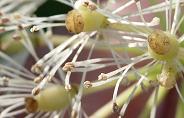
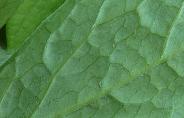
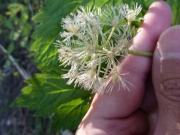
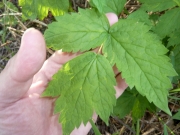
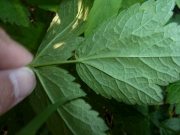
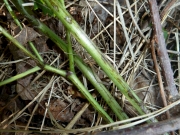
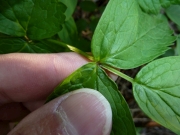
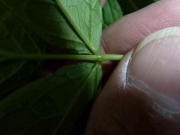
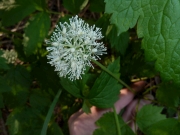
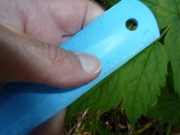
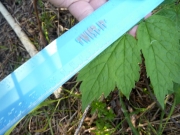
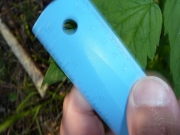
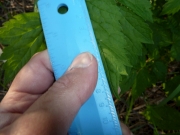
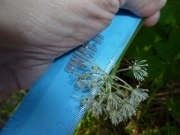
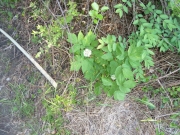
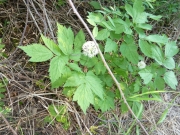

 This Forget-Me-Not is differentiated from other Forget-Me-Nots by stems branching
from the base of the plant, hairy thoughout and lower flowers scattered amongst
the leaves. A formal identification looks at:
This Forget-Me-Not is differentiated from other Forget-Me-Nots by stems branching
from the base of the plant, hairy thoughout and lower flowers scattered amongst
the leaves. A formal identification looks at:

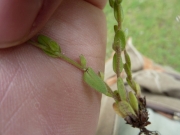
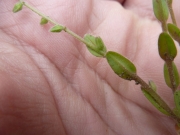
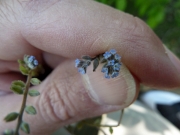
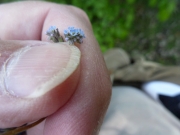
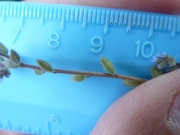
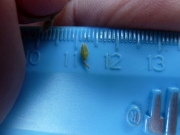
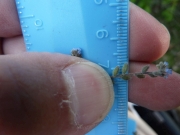
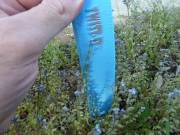
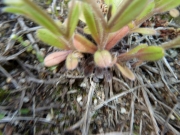
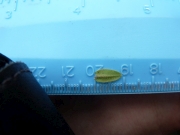
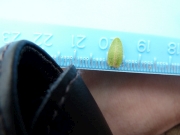
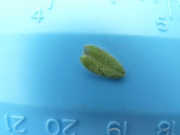
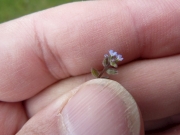
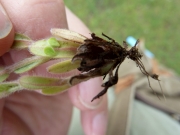
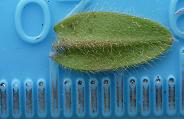

 For the last couple of years I was looking for a star-shaped version of False Solomon’s
Seal in hopes of finding Starry False Solomon’s Seal. But there are easier ways
to diferentiate Starry False Solomon’s Seal from Feathery False Solomon’s Seal
(Maianthemum racemosum).
For the last couple of years I was looking for a star-shaped version of False Solomon’s
Seal in hopes of finding Starry False Solomon’s Seal. But there are easier ways
to diferentiate Starry False Solomon’s Seal from Feathery False Solomon’s Seal
(Maianthemum racemosum).


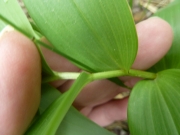
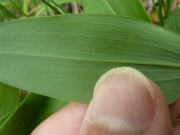
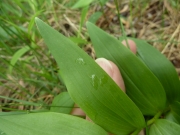
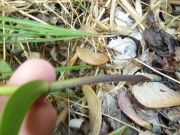
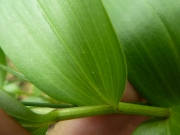
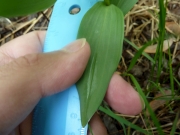
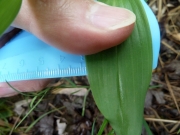
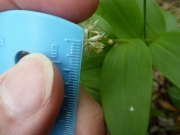
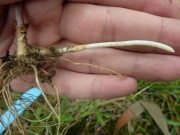
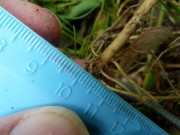
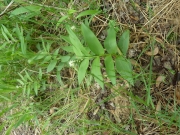
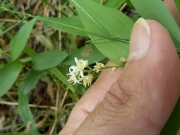

 I had given up ever finding Narrowleaf Plantain. Fortunately, the enormously tall
flower stems were up and some of them in flower to make identification a little
more certain. I was thrown off in identification by a couple of the misshapen
flower spikes as seen in some of the pictures below (where it looks like three
flower spikes are fused together).
I had given up ever finding Narrowleaf Plantain. Fortunately, the enormously tall
flower stems were up and some of them in flower to make identification a little
more certain. I was thrown off in identification by a couple of the misshapen
flower spikes as seen in some of the pictures below (where it looks like three
flower spikes are fused together).
 There are more Plantago species in New England than I was aware of (12!).
In addition to the distinctive basal lanceolate to narrowly-elliptical leaves and
the very tall flower stem, one picture flower shows the flower corolla being between
1.5 - 2.5 mm long and a close image shows the sepals being cililate at the tip.
There are more Plantago species in New England than I was aware of (12!).
In addition to the distinctive basal lanceolate to narrowly-elliptical leaves and
the very tall flower stem, one picture flower shows the flower corolla being between
1.5 - 2.5 mm long and a close image shows the sepals being cililate at the tip.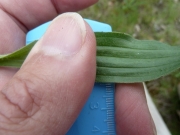
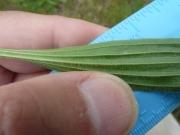
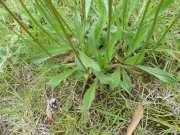
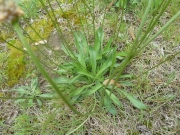
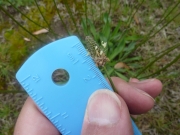
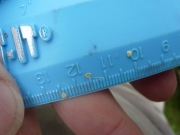
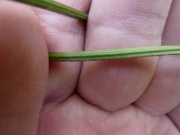

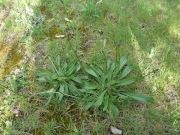
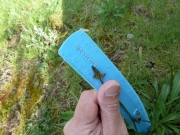
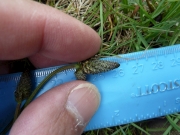
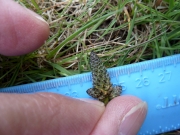
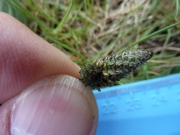
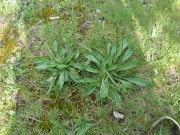
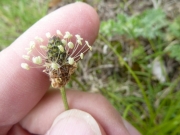
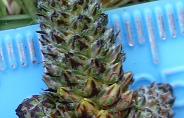

 This quick identification owes much thanks to the
XID Services Expert Identification Software.
When I have no idea what genus the plant is in, I often use this software to help
quickly identify the genus and sometimes species rather than flipping through pictures
in field guides and online references. I may be successful with this software in only
20-30% of the plants I look up (since the software only contains 1,000 broadleaf weeds),
but in those cases, it saves me hours. In this case, I marked the following attributes
in the software and three possibilities where returned:
This quick identification owes much thanks to the
XID Services Expert Identification Software.
When I have no idea what genus the plant is in, I often use this software to help
quickly identify the genus and sometimes species rather than flipping through pictures
in field guides and online references. I may be successful with this software in only
20-30% of the plants I look up (since the software only contains 1,000 broadleaf weeds),
but in those cases, it saves me hours. In this case, I marked the following attributes
in the software and three possibilities where returned:


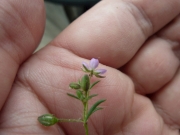
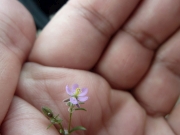
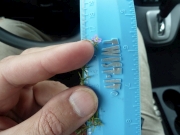
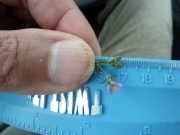

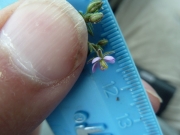
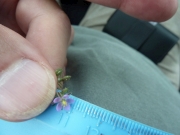
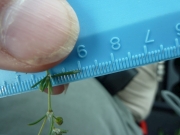
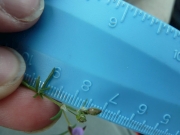

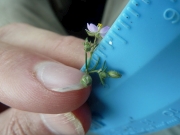
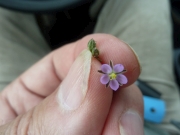
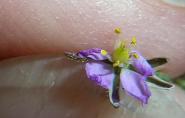

 I walked by these plants probably more than 100 times over the last few years and I
never noticed anything. But I’ll be looking for Huckleberries some time this
Summer! Only three Huckleberry plants grow in New England:
I walked by these plants probably more than 100 times over the last few years and I
never noticed anything. But I’ll be looking for Huckleberries some time this
Summer! Only three Huckleberry plants grow in New England:

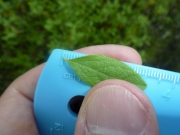
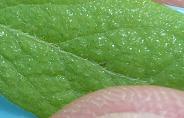
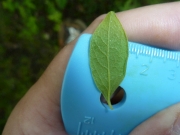
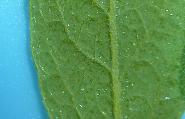
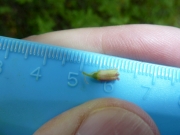
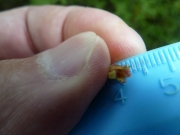
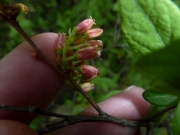
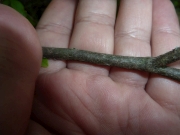
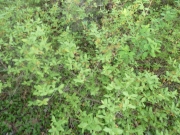
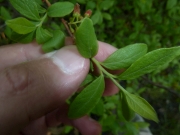
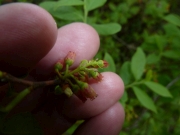
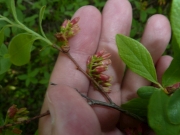

 This “burning bush”s is supposed to have bright red leaves in the Fall.
It is distinguished from other Euonymus species by the leaf petioles being
shorter than 5 mm (usually 1-3 mm) and the corky wings on the branchlets. (See last
image below.)
This “burning bush”s is supposed to have bright red leaves in the Fall.
It is distinguished from other Euonymus species by the leaf petioles being
shorter than 5 mm (usually 1-3 mm) and the corky wings on the branchlets. (See last
image below.)

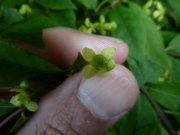
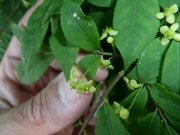
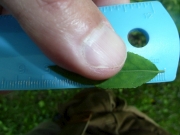
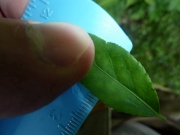
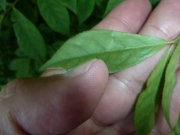
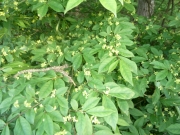
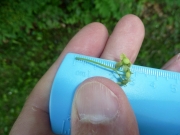
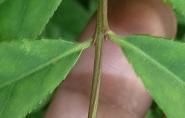

 One of the few purple violet species where the leaves and flower stalks grow
out of a stem (rather than out of the ground). Notice that this plant and its
leaves are very small compared to Viola sororia (for example).
One of the few purple violet species where the leaves and flower stalks grow
out of a stem (rather than out of the ground). Notice that this plant and its
leaves are very small compared to Viola sororia (for example).

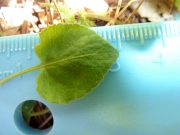
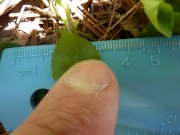
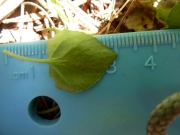
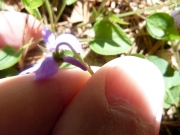
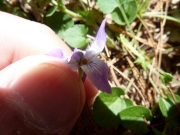
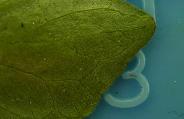
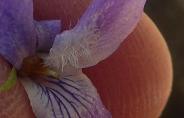

 The easiest way to identify a plant near someone's house is for the homeowner to come
out and tell you what was planted! There are a couple of interesting things about this
plant:
The easiest way to identify a plant near someone's house is for the homeowner to come
out and tell you what was planted! There are a couple of interesting things about this
plant:
 longer and lanceolate (especially the lower leaves)
to narrowly-oval while Annual Honesty leaves tend to be more triangular or heart-shaped.
For comparison, see the following page for
local
pictures of Dame’s Rocket.
longer and lanceolate (especially the lower leaves)
to narrowly-oval while Annual Honesty leaves tend to be more triangular or heart-shaped.
For comparison, see the following page for
local
pictures of Dame’s Rocket.
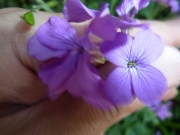
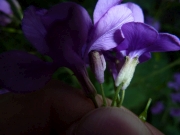
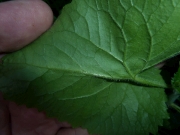
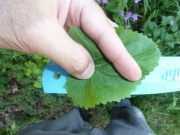
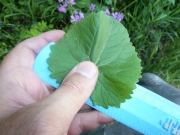
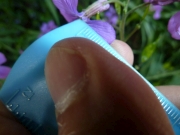
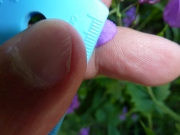
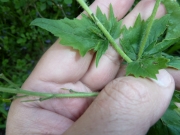
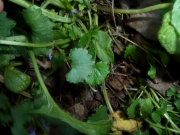
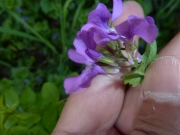
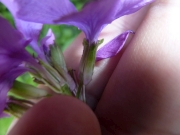
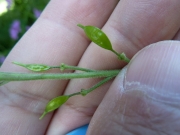
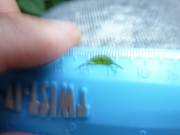
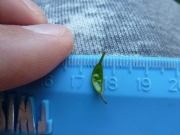
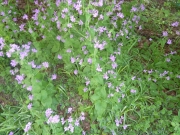

 There are only four yellow flower hawkweeds that are tall and have few to no stem leaves.
But it is still difficult to tell the difference between them.
There are only four yellow flower hawkweeds that are tall and have few to no stem leaves.
But it is still difficult to tell the difference between them.

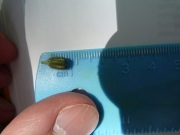
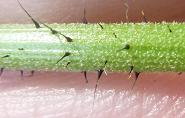
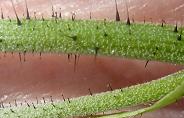
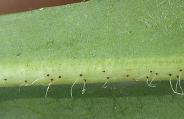
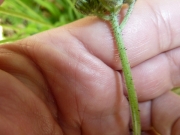
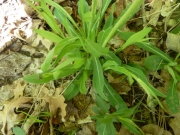
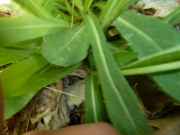
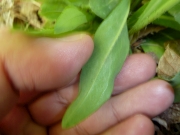

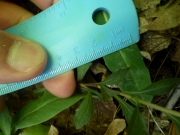
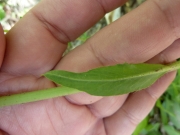
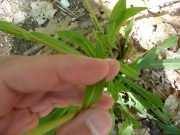
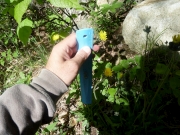
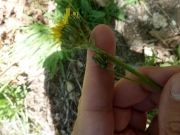
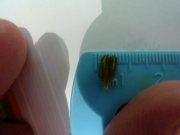
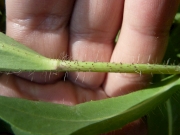
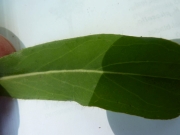
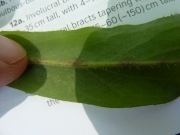
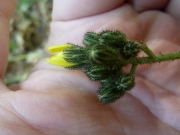
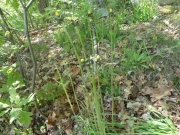
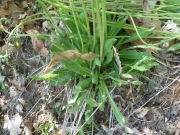

 The day before a plant identification class, I found this pussytoes plant a little ways
up a trail in the White Mountains in New Hampshire. There are only five species of
pussytoes in New England. Three of those have basal leaves that are less than
15 mm wide. Out of those three, only two have a “flag” (papery appendage)
at the tip of the stem leaves. Out of those two only Field Pussytoes has a matting of
wooly hairs on the back of the basal leaves.
The day before a plant identification class, I found this pussytoes plant a little ways
up a trail in the White Mountains in New Hampshire. There are only five species of
pussytoes in New England. Three of those have basal leaves that are less than
15 mm wide. Out of those three, only two have a “flag” (papery appendage)
at the tip of the stem leaves. Out of those two only Field Pussytoes has a matting of
wooly hairs on the back of the basal leaves.

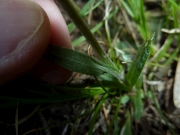
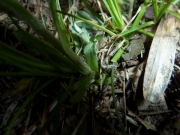
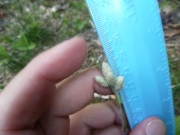
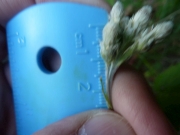
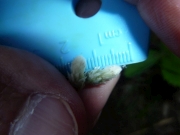
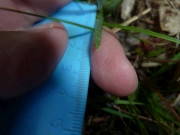
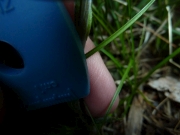
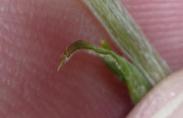

 I’ve been munching on the tops of these plants for weeks. The tops
(flowers and buds) of the plant can add some flavor to a salad or are a
good trail nibble. I do not remember seeing the plant last year, but there
are hundreds of them all over the place this year. They plants love to grow
next to foot paths and roads in the full sunlight.
I’ve been munching on the tops of these plants for weeks. The tops
(flowers and buds) of the plant can add some flavor to a salad or are a
good trail nibble. I do not remember seeing the plant last year, but there
are hundreds of them all over the place this year. They plants love to grow
next to foot paths and roads in the full sunlight.
 the six stamen
with curled green tops. Then, using the botanical guide by Arthur Haines,
Flora
Novae Angliae: A Manual for the Identification of Native and Naturalized
Higher Vascular Plants of New England, I was able to divine which of the
42 mustard genuses (in New England) that this plant belongs to:
the six stamen
with curled green tops. Then, using the botanical guide by Arthur Haines,
Flora
Novae Angliae: A Manual for the Identification of Native and Naturalized
Higher Vascular Plants of New England, I was able to divine which of the
42 mustard genuses (in New England) that this plant belongs to: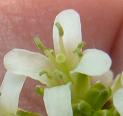
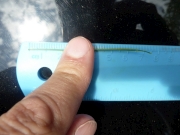
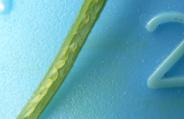
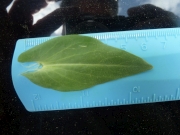
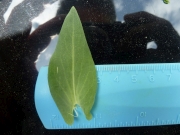

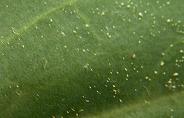
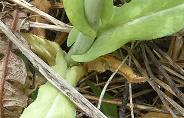
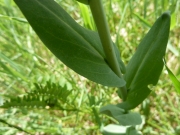
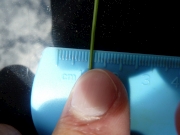
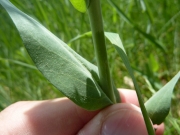
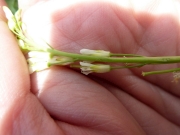
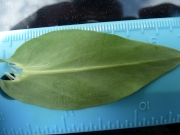
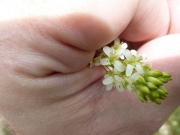
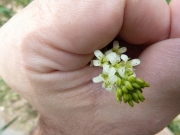

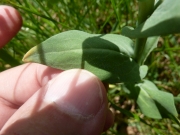
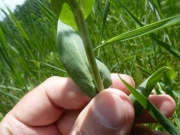
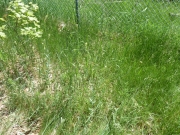
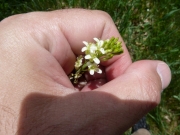

 I am still hoping to find a chickweed (Cerastium) one day. Both chickweed and
stitchworts are members of the Pink (Carnation) Family (Caryophyllaceae).
Plants in that family commonly have opposite leaves, nodes just below the leaves
are swollen, flowers with five petals and five sepals. Stitchworts and chickweeds have
five flower petals that are split, making it look like there are 10 petals. Stitchwort
flowers have only three styles while chickweed flowers have five (rarely four) styles.
Click on the closeup picture of the flower below and notice how the three, white, bent
pipe-cleaner-like things in the very center of the flower are the styles.
I am still hoping to find a chickweed (Cerastium) one day. Both chickweed and
stitchworts are members of the Pink (Carnation) Family (Caryophyllaceae).
Plants in that family commonly have opposite leaves, nodes just below the leaves
are swollen, flowers with five petals and five sepals. Stitchworts and chickweeds have
five flower petals that are split, making it look like there are 10 petals. Stitchwort
flowers have only three styles while chickweed flowers have five (rarely four) styles.
Click on the closeup picture of the flower below and notice how the three, white, bent
pipe-cleaner-like things in the very center of the flower are the styles.
 To see what type of stitchwort this is, I had to go through the key in the
botanical guide by Arthur Haines,
Flora
Novae Angliae: A Manual for the Identification of Native and Naturalized
Higher Vascular Plants of New England:
To see what type of stitchwort this is, I had to go through the key in the
botanical guide by Arthur Haines,
Flora
Novae Angliae: A Manual for the Identification of Native and Naturalized
Higher Vascular Plants of New England: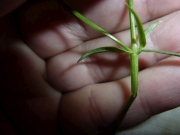
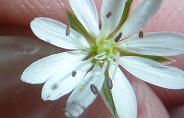
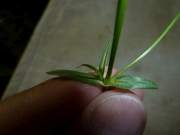
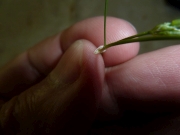
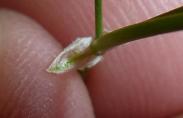
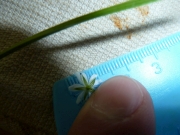

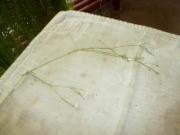
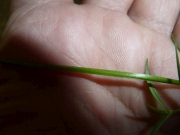
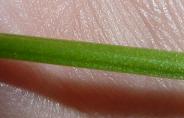
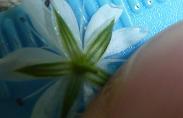
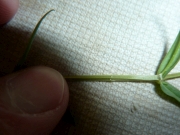
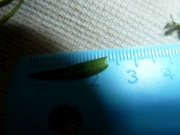
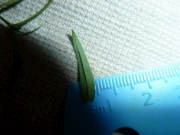
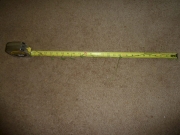
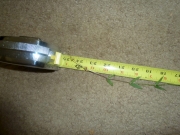
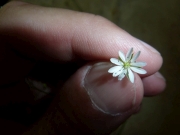
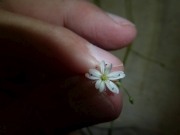
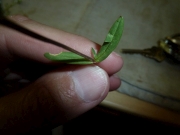
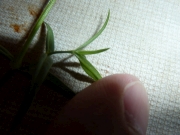

 I am still fairly weak in my knowledge of trees and find it challenging to
identify trees that seem easy for others to learn. This one appears to be
American Elm. Elm tree leaves have double-serrated teeth, meaning that
the teeth have smaller teeth on them. The main teeth on these leaves are
so large that you have to look closely to see the smaller teeth within
the bigger teeth. Leaves are alternate and have uneven bases.
I am still fairly weak in my knowledge of trees and find it challenging to
identify trees that seem easy for others to learn. This one appears to be
American Elm. Elm tree leaves have double-serrated teeth, meaning that
the teeth have smaller teeth on them. The main teeth on these leaves are
so large that you have to look closely to see the smaller teeth within
the bigger teeth. Leaves are alternate and have uneven bases.
 One of the most certain ways to tell the difference between American Elm and
Slipper Elm (Ulmus rubra) is the lateral veins on the American Elm leaf
blade do not fork (branch) until near the edge (margin) of the leaf. (In rare
cases, one lateral vein may have a fork well before the edge on an American Elm
leaf.) On a Slipper Elm leaf, the there will be at least two and sometimes many forks
well before the edge of the leaf. In addition, Slipper Elm leaves tend to be rough
on the top of the leaf and much more densely hairy on the back of the leaf. Buds
and twigs on the American Elm tend to be brownish while twigs on the Slippery Elm
are grayish and the buds are rusty brown to black. Finally, cutting a cross section
of bark from American Elm will show an alternating pale and dark bands which are not
seen in Slippery Elm bark.
One of the most certain ways to tell the difference between American Elm and
Slipper Elm (Ulmus rubra) is the lateral veins on the American Elm leaf
blade do not fork (branch) until near the edge (margin) of the leaf. (In rare
cases, one lateral vein may have a fork well before the edge on an American Elm
leaf.) On a Slipper Elm leaf, the there will be at least two and sometimes many forks
well before the edge of the leaf. In addition, Slipper Elm leaves tend to be rough
on the top of the leaf and much more densely hairy on the back of the leaf. Buds
and twigs on the American Elm tend to be brownish while twigs on the Slippery Elm
are grayish and the buds are rusty brown to black. Finally, cutting a cross section
of bark from American Elm will show an alternating pale and dark bands which are not
seen in Slippery Elm bark.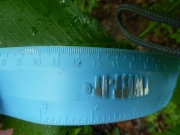
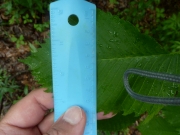
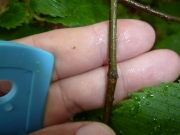
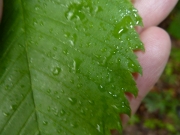
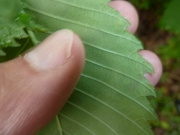
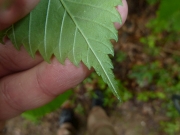

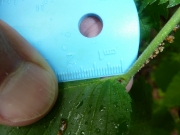
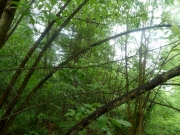
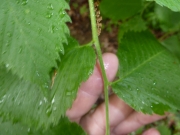
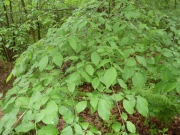

 Supposedly, the only New England state that this plant grows in is Massachusetts. But
Rhododendrons can be planted anywhere. This was found in a clump of bushes, very close
to a business. Pink flowers, no scales on the leaves (see closeup image) and large
leaves (10-20 cm long) led me to two possible Rhododendron choices. Short sepals
(0.5 - 1.7 mm long) and wider leaves (1.5 - 2.5 times as long as wide) helped me
decide that this was Catawba Rosebay.
Supposedly, the only New England state that this plant grows in is Massachusetts. But
Rhododendrons can be planted anywhere. This was found in a clump of bushes, very close
to a business. Pink flowers, no scales on the leaves (see closeup image) and large
leaves (10-20 cm long) led me to two possible Rhododendron choices. Short sepals
(0.5 - 1.7 mm long) and wider leaves (1.5 - 2.5 times as long as wide) helped me
decide that this was Catawba Rosebay.


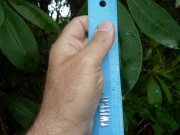
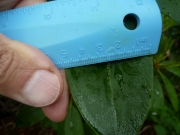
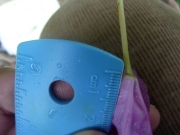
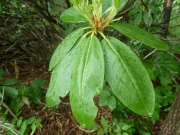
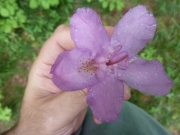
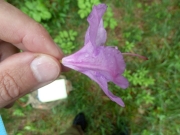
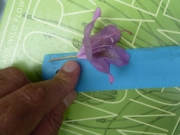
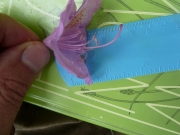
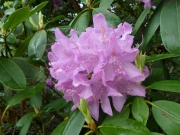
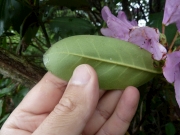
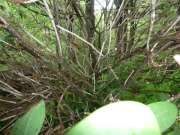
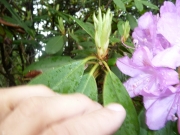
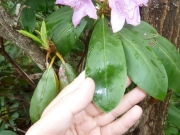

 My first time locating a chickweed! A nice-sized patch of it was no more than
50 yards from my front door!
My first time locating a chickweed! A nice-sized patch of it was no more than
50 yards from my front door!


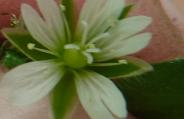
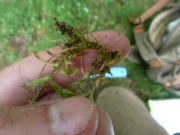
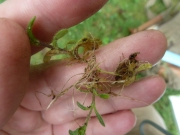
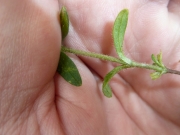
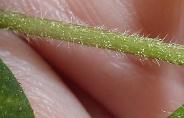
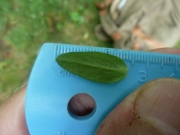
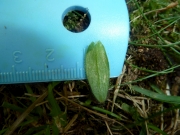
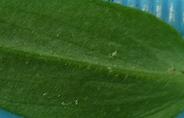
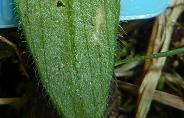
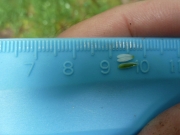
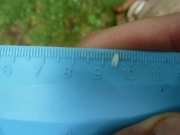
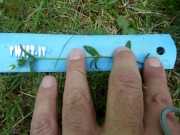
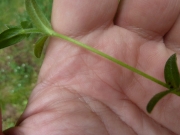
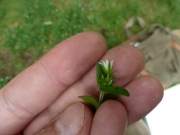
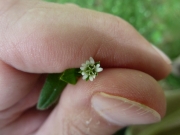
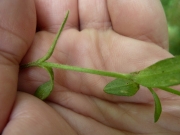
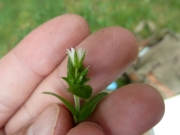

 This flower is so tiny that it’s hard to see unless your face is on top
of the plant. Like the Thyme-Leaved Speedwell (Veronica serpyllifolia),
the flowers fall off with the slightest shaking of the plant. Because I dug up
a plant, it was very easy to follow the key to the proper identification:
This flower is so tiny that it’s hard to see unless your face is on top
of the plant. Like the Thyme-Leaved Speedwell (Veronica serpyllifolia),
the flowers fall off with the slightest shaking of the plant. Because I dug up
a plant, it was very easy to follow the key to the proper identification:

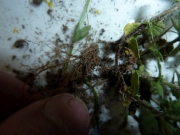

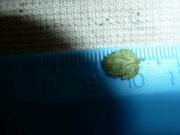
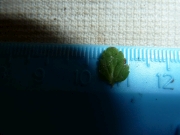
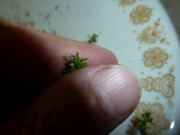
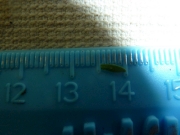
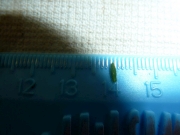
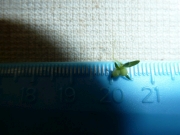
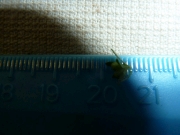
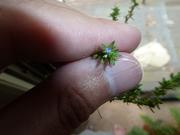
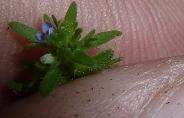
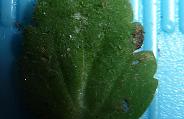
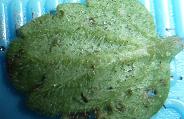

 There were a number of things that made this a very difficult identification and
I’m not 100% sure it is accurate. I was taking pictures right outside of
someone’s apartment and I think that were wondering what the *!*$(@ I was
doing! Also, the key led me to information on flower parts and I can’t pick
out flower parts very well. Fortunately, it had the obvious look of a buttercup:
There were a number of things that made this a very difficult identification and
I’m not 100% sure it is accurate. I was taking pictures right outside of
someone’s apartment and I think that were wondering what the *!*$(@ I was
doing! Also, the key led me to information on flower parts and I can’t pick
out flower parts very well. Fortunately, it had the obvious look of a buttercup: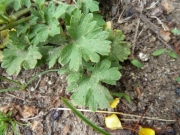
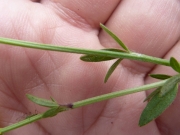
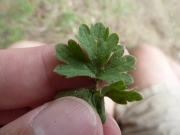
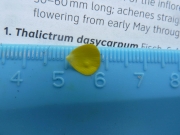
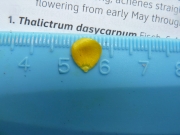
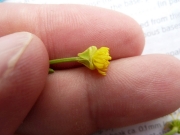
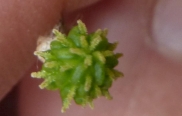

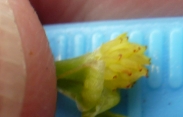
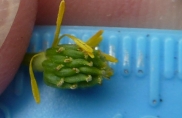
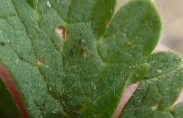
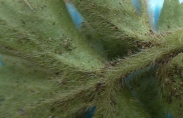
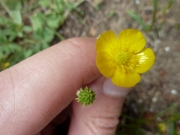
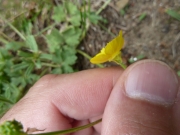
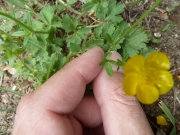
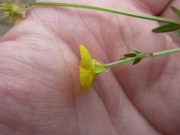
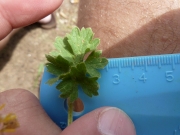
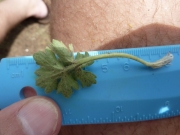
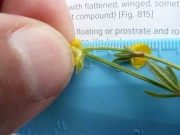
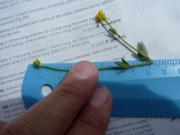
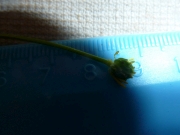
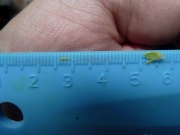
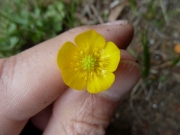
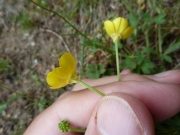
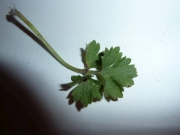
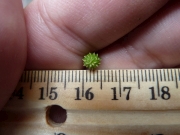
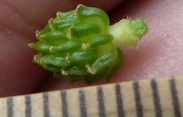
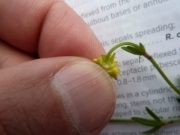
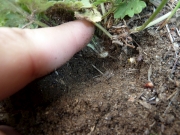
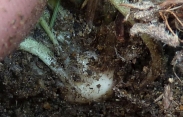

 Fortunately, there are not many trees that have pinnately-compound leaves. In this case,
every leaf had very large, toothed leaflets. The only trees that are pinnately-compound
and with leaflets this big are the hickory (Carya) species. Since there are only five
species of hickory in New England, I thought it would be easy. I narrowed it down to
Shagbark Hickory (Carya ovata) and Pignut Hickory (Carya glabra).
Fortunately, there are not many trees that have pinnately-compound leaves. In this case,
every leaf had very large, toothed leaflets. The only trees that are pinnately-compound
and with leaflets this big are the hickory (Carya) species. Since there are only five
species of hickory in New England, I thought it would be easy. I narrowed it down to
Shagbark Hickory (Carya ovata) and Pignut Hickory (Carya glabra).
 Click on
the two closeup pictures of the leaf teeth below (and then click one more time to expand
again) to see that the leaf margins have clumps of hair near the teeth. This is a sign
that this tree is Shagbark Hickory. The tree is not old enough for the bark to shag into
long plates that are free at the bottom.
Click on
the two closeup pictures of the leaf teeth below (and then click one more time to expand
again) to see that the leaf margins have clumps of hair near the teeth. This is a sign
that this tree is Shagbark Hickory. The tree is not old enough for the bark to shag into
long plates that are free at the bottom.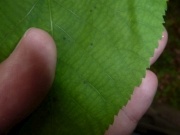
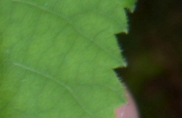
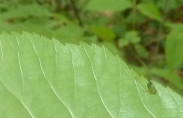
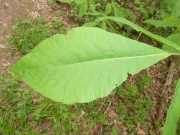
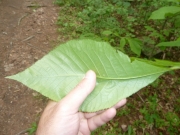
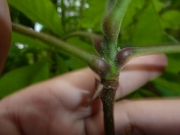
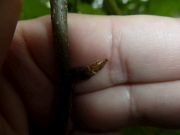
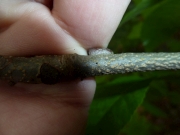
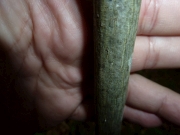
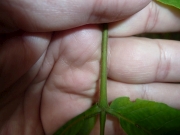
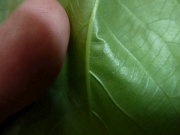
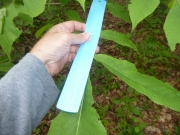

 I love the look of this flower! And it was easy to identify! Trifoliate leaves.
It is a member of the Buttercup family.
I love the look of this flower! And it was easy to identify! Trifoliate leaves.
It is a member of the Buttercup family.

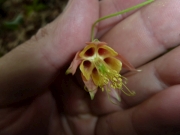
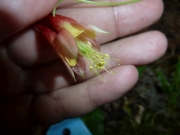
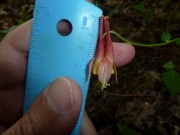
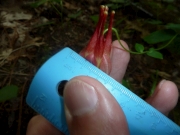
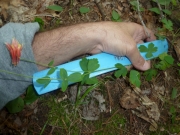
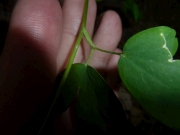
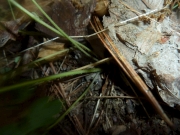
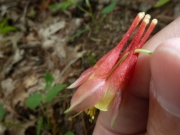
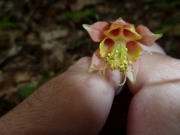
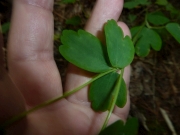
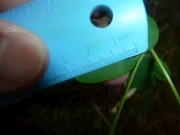
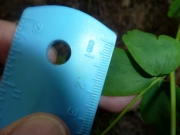
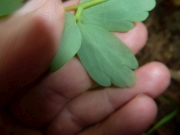

 I have been looking for Leafy Spurge ever since I found the similar Cypress Spurge
(Euphorbia cyparissias) a few years ago. Leafy spurge is clearly much bigger
and with much larger leaves. There is a rare hybrid of these two plants known as
Euphorbia x pseudoesula. The leaf blades of the hybrid appear 35 mm long and
3 mm wide and a similar shape as Cypress Spurge leaves (narrow and linear). But the
flowers are found in both a terminal cyme and in the leaf axils similar to Leafy
Spurge.
I have been looking for Leafy Spurge ever since I found the similar Cypress Spurge
(Euphorbia cyparissias) a few years ago. Leafy spurge is clearly much bigger
and with much larger leaves. There is a rare hybrid of these two plants known as
Euphorbia x pseudoesula. The leaf blades of the hybrid appear 35 mm long and
3 mm wide and a similar shape as Cypress Spurge leaves (narrow and linear). But the
flowers are found in both a terminal cyme and in the leaf axils similar to Leafy
Spurge.
 Some might categorize this plant as Russian Leafy Spurge (Slender Leafy Spurge)
(Euphorbia virgata) because stem leaf blades are linear, greater than
six times longer than wide and widest below the middle. However, some authors
categorize Russian Leafy Spurge as a subspecies (Euphorbia esula ssp.
tommasiniana), some categorize it s a variety (Euphorbia esula var.
uralensis or Euphorbia esula var. orientalis) and some consider it a
separate species (Euphorbia virgata). In addition, some authors recognize
a hybrid between Euphorbia esula and Eurphorbia virgata and call
that hybrid Euphorbia x pseudovirgata. Until the confusion is worked out,
I will categorize this plant as Euphorbia esula and leave it to the botanists
to figure it out.
Some might categorize this plant as Russian Leafy Spurge (Slender Leafy Spurge)
(Euphorbia virgata) because stem leaf blades are linear, greater than
six times longer than wide and widest below the middle. However, some authors
categorize Russian Leafy Spurge as a subspecies (Euphorbia esula ssp.
tommasiniana), some categorize it s a variety (Euphorbia esula var.
uralensis or Euphorbia esula var. orientalis) and some consider it a
separate species (Euphorbia virgata). In addition, some authors recognize
a hybrid between Euphorbia esula and Eurphorbia virgata and call
that hybrid Euphorbia x pseudovirgata. Until the confusion is worked out,
I will categorize this plant as Euphorbia esula and leave it to the botanists
to figure it out.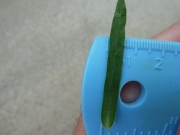
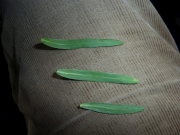

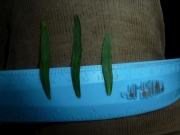
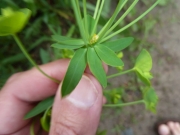
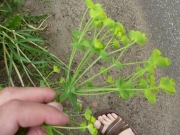
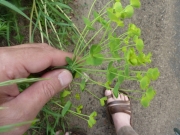
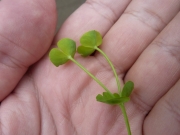
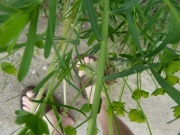
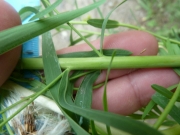
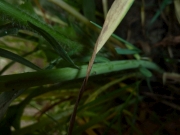
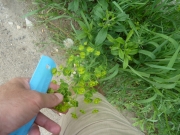

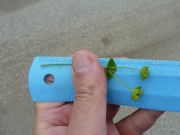
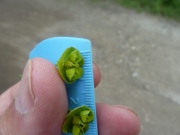
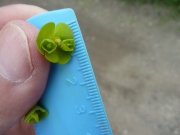
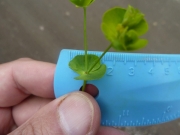
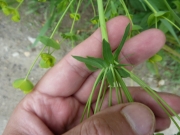
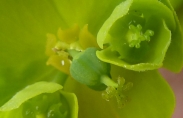

 I went to a 3-hour presentation on Edible Forest Gardens. It was inspiring! Then I
want for a walk at a nearby set of trails. This is one of many new and interesting
plants flowering by the stream.
I went to a 3-hour presentation on Edible Forest Gardens. It was inspiring! Then I
want for a walk at a nearby set of trails. This is one of many new and interesting
plants flowering by the stream.

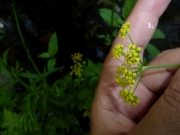
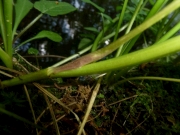
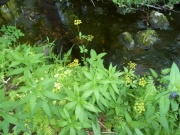
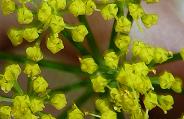
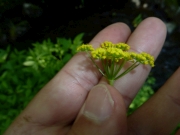
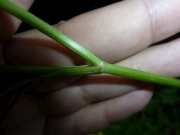
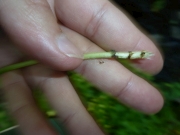
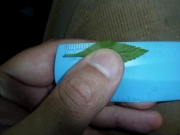
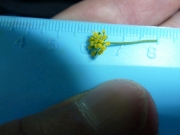
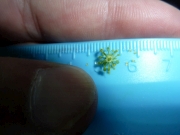
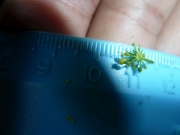
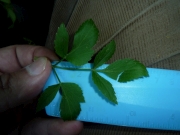
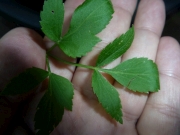
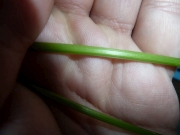
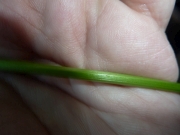
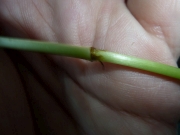

 These plants were growing right between at the edge of a parking lot that is
adjacent to a forest walking path. Other plants growing in this weedy area were
species of bedstraw, speedwell, buttercup, periwinkle and wild carrot. When you
do not grow your own vegetables, you have no idea what the flowering plant looks
like.
These plants were growing right between at the edge of a parking lot that is
adjacent to a forest walking path. Other plants growing in this weedy area were
species of bedstraw, speedwell, buttercup, periwinkle and wild carrot. When you
do not grow your own vegetables, you have no idea what the flowering plant looks
like.

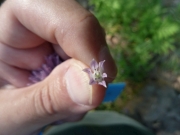
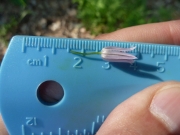
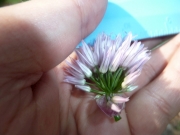
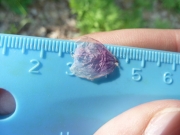
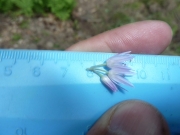
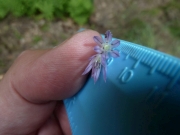
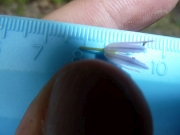
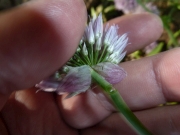

 Other than Sensative Fern (Onoclea sensibilis), which is easy to identify, this is my very first
fern identification that I have done on my own! I was not planning on identifying ferns,
but that big cinnamon-colored center part of the fern rosette made identification possible.
Cinnamon Fern has a circular rosette of leaves (called fronds) that are infertile and
then one or more central, cinnamon-colored fertile fronds (that release spores).
Other than Sensative Fern (Onoclea sensibilis), which is easy to identify, this is my very first
fern identification that I have done on my own! I was not planning on identifying ferns,
but that big cinnamon-colored center part of the fern rosette made identification possible.
Cinnamon Fern has a circular rosette of leaves (called fronds) that are infertile and
then one or more central, cinnamon-colored fertile fronds (that release spores).
 Each large leaf has many leaflets that get smaller as they approach the tip of the leaf.
In the first top picture (above), to the right, we are looking at the back of part of
one leaflet. There is hairy fuzz where the leaflet connects to the leaf stem. Some
people call this “hairy armpits” and is a significant identifying feature
of Cinnamon Fern. Notice that the leaflets are very deeply cut, almost into leafules
(leaflets of leaflets), but not quite. Identification keys include:
“hairy armpits”; thin, cinnamon-colored fertile frond; and leaflets of
infertile front coming to a point (see last picture below).
Each large leaf has many leaflets that get smaller as they approach the tip of the leaf.
In the first top picture (above), to the right, we are looking at the back of part of
one leaflet. There is hairy fuzz where the leaflet connects to the leaf stem. Some
people call this “hairy armpits” and is a significant identifying feature
of Cinnamon Fern. Notice that the leaflets are very deeply cut, almost into leafules
(leaflets of leaflets), but not quite. Identification keys include:
“hairy armpits”; thin, cinnamon-colored fertile frond; and leaflets of
infertile front coming to a point (see last picture below).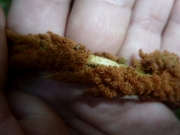
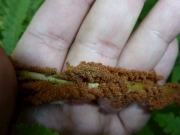
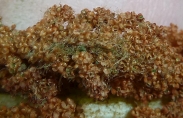
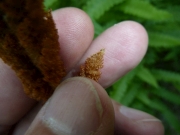
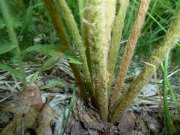
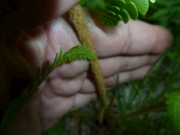
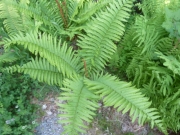
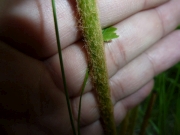
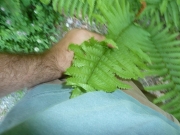
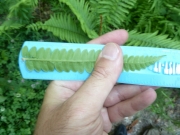

 The light-colored splotches (spots) on the tops of the leaves help identify this Buttercup.
Notice in the pictures below that the sepals are spread (not recurved down), the plant
spreads with runners.
The light-colored splotches (spots) on the tops of the leaves help identify this Buttercup.
Notice in the pictures below that the sepals are spread (not recurved down), the plant
spreads with runners.

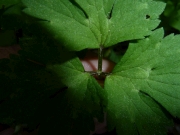
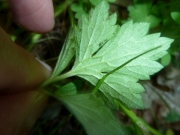
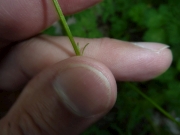
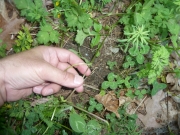
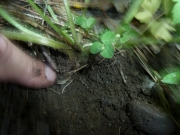
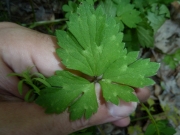
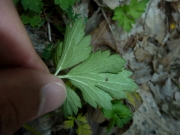
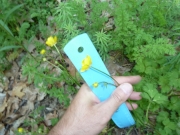
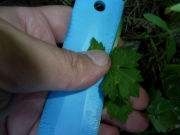
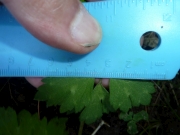
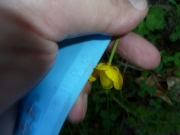
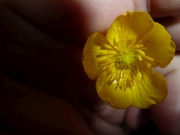
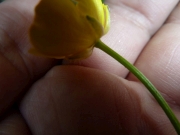
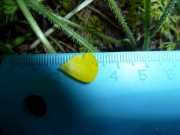
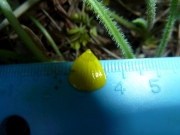
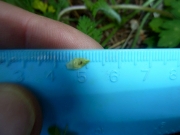
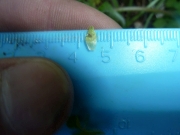

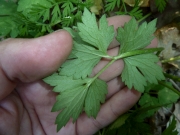
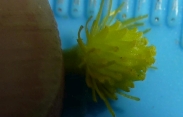

 There are 22 Bedstraw (Galium) species in New England. Fortunately, half of
those species have four or fewer leaves at each node. This species was keyed out as
follows:
There are 22 Bedstraw (Galium) species in New England. Fortunately, half of
those species have four or fewer leaves at each node. This species was keyed out as
follows:

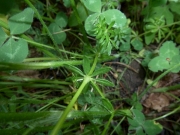
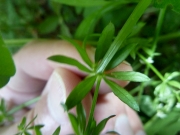
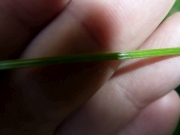
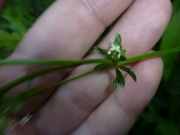

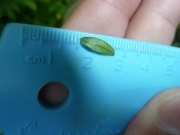
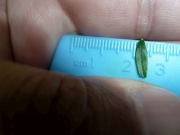
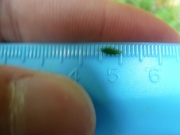
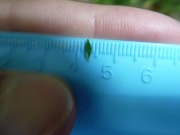
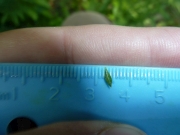
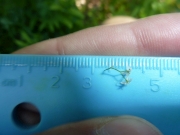
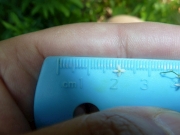
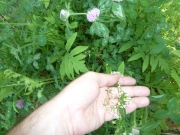
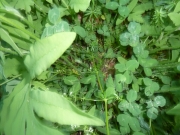
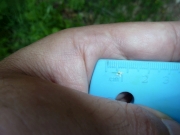
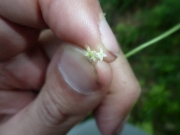

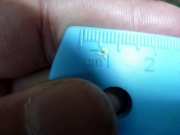

 I walked by this area 100 times last year and did not see this plant. But there was
only one of these plants in the dirt about 50 feet from a corn field (probably
genetically manipulated corn). I guess I’m a little miffed at this farm
because they leased some of the land from the city and then cleared the land to plant
corn. By doing so they destroyed a great field with Sowthistle, Lobelia,
Canada Thistle, Red Clover and Hedge False Bindweed. This is my second favorite
flower after Red Columbine.
I walked by this area 100 times last year and did not see this plant. But there was
only one of these plants in the dirt about 50 feet from a corn field (probably
genetically manipulated corn). I guess I’m a little miffed at this farm
because they leased some of the land from the city and then cleared the land to plant
corn. By doing so they destroyed a great field with Sowthistle, Lobelia,
Canada Thistle, Red Clover and Hedge False Bindweed. This is my second favorite
flower after Red Columbine.

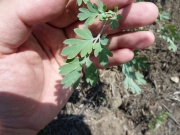
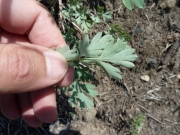
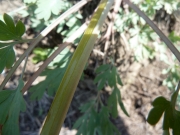
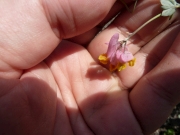
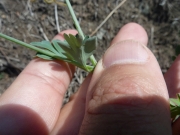
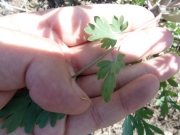

 I found giant chickweed growing next to a corn field. Given the species name,
aquaticum, I would have expected to find it near water. On the other hand,
perhaps it is getting some water for the watering of the corn field. So, I went through
the whole Caryophyllaceae (Pink) family to see if it could be anything else:
I found giant chickweed growing next to a corn field. Given the species name,
aquaticum, I would have expected to find it near water. On the other hand,
perhaps it is getting some water for the watering of the corn field. So, I went through
the whole Caryophyllaceae (Pink) family to see if it could be anything else:

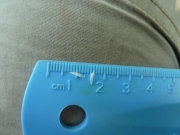
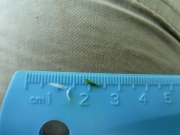
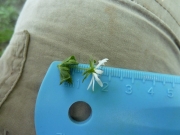
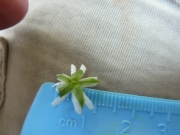
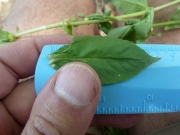
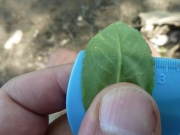
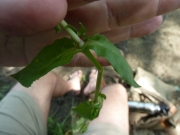
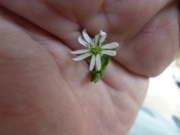
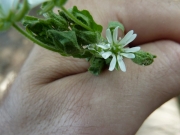
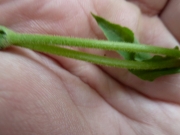

 Barely touching this plant will make the flowers fall off, just like Corn Speedwell and
Thyme-Leaved Speedwell. It was dusk and the mosquitoes were swarming and I was lying in
the tick-infested grass and being as still as humanly possible to try and take pictures
without all of the flowers falling off.
Barely touching this plant will make the flowers fall off, just like Corn Speedwell and
Thyme-Leaved Speedwell. It was dusk and the mosquitoes were swarming and I was lying in
the tick-infested grass and being as still as humanly possible to try and take pictures
without all of the flowers falling off.
 Key:
Key: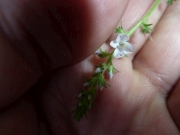
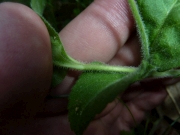
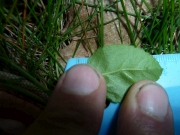
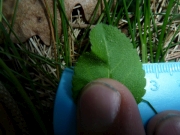

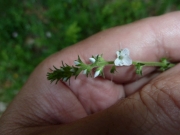
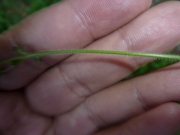
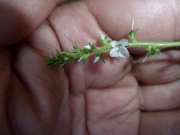

 This plant is poisonous, the root being the most poisonous part. However, Native
Americans and herbalists have used minute amounts of the rhizome medicinally, harvested
in the Winter when the poison levels are at their lowest.
This plant is poisonous, the root being the most poisonous part. However, Native
Americans and herbalists have used minute amounts of the rhizome medicinally, harvested
in the Winter when the poison levels are at their lowest.

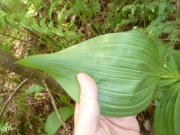
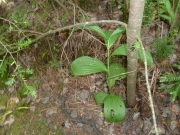
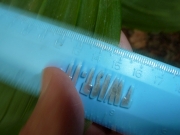
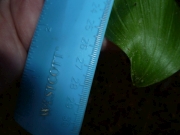
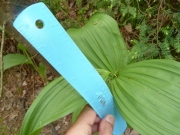

 I kept thinking that this might be Red-Seeded Dandelion (Taraxacum laevigatum)
because it looked like a small dandelion. There were hundreds of these plants by a farm
and a few by my home. I went through the entire key for the Aster Family (Asteraceae)
to confirm identification!
I kept thinking that this might be Red-Seeded Dandelion (Taraxacum laevigatum)
because it looked like a small dandelion. There were hundreds of these plants by a farm
and a few by my home. I went through the entire key for the Aster Family (Asteraceae)
to confirm identification!
 If you look at the pictures below, you can see closeups of the pappus. A pappus is a
modified outer whorl of flowers of the Asteraceae family. It consists of the
achene (seed) with bristles or scales at the top of the achene. This species has five
white scales (that look a bit like flower petals) and five long bristles. A related
species, Two-Flowered Dwarf Dandelion (Krigia biflora) has 10 scales and 20-35
long bristles.
If you look at the pictures below, you can see closeups of the pappus. A pappus is a
modified outer whorl of flowers of the Asteraceae family. It consists of the
achene (seed) with bristles or scales at the top of the achene. This species has five
white scales (that look a bit like flower petals) and five long bristles. A related
species, Two-Flowered Dwarf Dandelion (Krigia biflora) has 10 scales and 20-35
long bristles.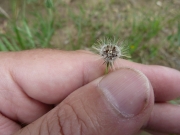
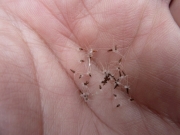
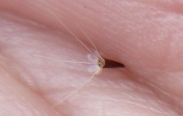

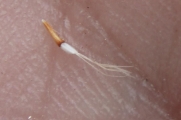
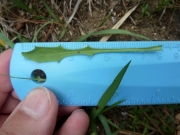
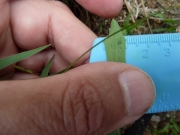
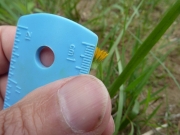
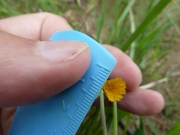
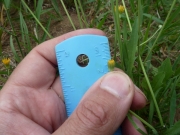
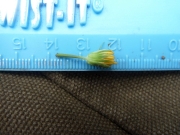
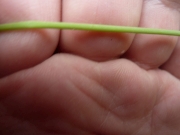
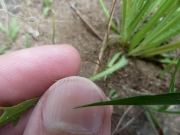
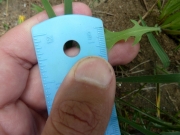
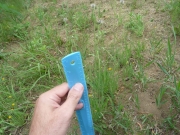

 I must have forgotten to post this plant to the web page last year. It is the easiest
ferm to identify because it’s so unique-looking. Only the Netted Chain Fern
(Woodwardia areolata) has any resemblence to Sensitive Fern. There are some
obvious differences:
I must have forgotten to post this plant to the web page last year. It is the easiest
ferm to identify because it’s so unique-looking. Only the Netted Chain Fern
(Woodwardia areolata) has any resemblence to Sensitive Fern. There are some
obvious differences:

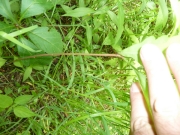
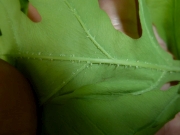
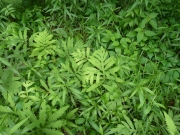

 More than plants on the trails!
More than plants on the trails!
 This plant doesn't grow as upright as Mouse-Ear Chickweed (Cerastium fontanum).
But the main differences are that this plant does not have sprawling stems that root
at the nodes and the flower has five stamen.
This plant doesn't grow as upright as Mouse-Ear Chickweed (Cerastium fontanum).
But the main differences are that this plant does not have sprawling stems that root
at the nodes and the flower has five stamen.

